Functional Surface Generation by EDM—A Review
Abstract
1. Introduction
1.1. Brief Overview of the EDM Process
1.2. How the Surface Modification Happens Naturally in the EDM Process
2. Purpose of Surface Generation/Modification/Coating
2.1. To Enhance Surface Properties
2.2. To Enhance Biocompatibility and Corrosion Resistance of the Surface
3. Electro-Discharge-Based Surface Modification and Coating Techniques
3.1. Traditional EDM Processes: Die-Sinking and Wire-EDM
3.2. Powder-Mixed EDM
3.3. Micro-EDM
3.4. EDM with Composite Electrodes
4. Characterization Techniques Used to Investigate Surface and Sub-Surface Modification by EDM
4.1. Tribo-Testing of EDMed Surface for Tribological Chracterization
4.2. Surface Characterization and Composition Analysis by SEM and EDS
4.3. Phase Characterization Using the XRD Technique
5. Application of Electro-Discharge Surface Modification and Coating
5.1. Surface Modification for Protective Coating
5.2. Surface Modification for Enhancing Biocompatibility of Implants
5.3. Surface Modification for Improved Tribological Performance
6. EDM-Based Novel Techniques of Surface Modification and Applications
7. Future Research Directions
8. Conclusions
Author Contributions
Funding
Data Availability Statement
Conflicts of Interest
References
- Ho, K.H.; Newmann, S.T. State of the art electrical discharge machining (EDM). Int. J. Mach. Tools Manuf. 2003, 43, 1287–1300. [Google Scholar] [CrossRef]
- Ramasawmy, H.; Blunt, L. Effect of EDM process parameters on 3D surface topography. J. Mater. Process. Technol. 2004, 148, 155–164. [Google Scholar] [CrossRef]
- Gentili, E.; Tabaglio, L.; Aggogeri, F. Review on micromachining techniques. Courses Lect. Int. Cent. Mech. Sci. 2005, 486, 387–396. [Google Scholar]
- McGeough, J.A.; Rasmussen, H. A macroscopic model of electro-discharge machining. Int. J. Mach. Tool Des. Res. 1982, 22, 333–339. [Google Scholar] [CrossRef]
- Schumacher, B.M. After 60 years of EDM the discharge process remains still disputed. J. Mater. Process. Technol. 2004, 149, 376–381. [Google Scholar] [CrossRef]
- Jahan, M.P. Micro-electrical discharge machining. Nontradit. Mach. Process. 2013, 1, 111–151. [Google Scholar]
- Jameson, E.C. Description and Development of Electrical Discharge Machining; Society of Manufacturing Engineers: Dearbern, MI, USA, 2001. [Google Scholar]
- Han, F.; Wachi, S.; Kunieda, M. Improvement of machining characteristics of micro-EDM using transistor type isopulse generator and servo feed control. Precis. Eng. 2004, 28, 378–385. [Google Scholar] [CrossRef]
- Maher, I.; Ling, L.H.; Sarhan, A.A.; Hamdi, M. Improve wire EDM performance at different machining parameters-ANFIS modeling. IFAC-PapersOnLine 2015, 48, 105–110. [Google Scholar] [CrossRef]
- Salonitis, K.; Stournaras, A.; Stavropoulos, P.; Chryssolouris, G. Thermal modeling of the material removal rate and surface roughness for die-sinking EDM. Int. J. Adv. Manuf. Technol. 2009, 40, 316–323. [Google Scholar] [CrossRef]
- Manna, A.; Bhattacharyya, B. Taguchi and Gauss elimination method: A dual response approach for parametric optimization of CNC wire cut EDM of PRAlSiCMMC. Int. J. Adv. Manuf. Technol. 2006, 28, 67–75. [Google Scholar] [CrossRef]
- Rajesha, S.; Sharma, A.K.; Kumar, P. Some aspects of surface integrity study of electro discharge machined Inconel 718. In Proceedings of the 36th International MATADOR Conference, Belin, Germany, 14 July 2010; pp. 439–444. [Google Scholar]
- Kumar, S.; Singh, R.; Singh, T.P.; Sethi, B.L. Surface modification by electrical discharge machining: A review. J. Mater. Process. Technol. 2009, 209, 3675–3687. [Google Scholar] [CrossRef]
- Pramanik, A.; Basak, A.K. Effect of wire electric discharge machining (EDM) parameters on fatigue life of Ti-6Al-4V alloy. Int. J. Fatigue 2019, 128, 105186. [Google Scholar] [CrossRef]
- Świercz, R.; Oniszczuk-Świercz, D.; Chmielewski, T. Multi-response optimization of electrical discharge machining using the desirability function. Micromachines 2019, 10, 72. [Google Scholar] [CrossRef]
- Khosrozadeh, B.; Shabgard, M. Effects of hybrid electrical discharge machining processes on surface integrity and residual stresses of Ti-6Al-4V titanium alloy. Int. J. Adv. Manuf. Technol. 2017, 93, 1999–2011. [Google Scholar] [CrossRef]
- Oskuie, A.A.; Shahrabi, T.; Lajevardi, A. Failure of pipeline expander segments due to undesirable EDM. Eng. Fail. Anal. 2013, 28, 34–46. [Google Scholar] [CrossRef]
- Chen, Z.; Moverare, J.; Peng, R.L.; Johansson, S. Surface integrity and fatigue performance of Inconel 718 in wire electrical discharge machining. Procedia CIRP 2016, 45, 307–310. [Google Scholar] [CrossRef]
- Okada, A. Formation of Hard Layer by EDM with Carbon Powder Mixed Fluid. In Proceedings of the 5th International Conference on Progress of Machining Technology, Beijing, China, 19–21 June 2000; Volume 464, pp. 464–469. [Google Scholar]
- Wang, Z.L.; Fang, Y.; Wu, P.N.; Zhao, W.S.; Cheng, K. Surface modification process by electrical discharge machining with a Ti powder green compact electrode. J. Mater. Process. Technol. 2002, 129, 139–142. [Google Scholar] [CrossRef]
- Samuel, M.P.; Philip, P.K. Powder metallurgy tool electrodes for electrical discharge machining. Int. J. Mach. Tools Manuf. 1997, 37, 1625–1633. [Google Scholar] [CrossRef]
- Li, L.; Wong, Y.S.; Fuh, J.Y.H.; Lu, L. EDM performance of TiC/copper-based sintered electrodes. Mater. Des. 2001, 22, 669–678. [Google Scholar] [CrossRef]
- Yan, B.H.; Tsai, H.C.; Huang, F.Y. The effect in EDM of a dielectric of a urea solution in water on modifying the surface of titanium. Int. J. Mach. Tools Manuf. 2005, 45, 194–200. [Google Scholar] [CrossRef]
- Furutania, K.; Saneto, A.; Takezawa, H.; Mohri, N.; Miyake, H. Accretion of titanium carbide by electrical discharge machining with powder suspended in working fluid. Precis. Eng. 2001, 25, 138–144. [Google Scholar] [CrossRef]
- Allen, T.; Busby, J.; Meyer, M.; Petti, D. Materials challenges for nuclear systems. Mater. Today 2010, 13, 14–23. [Google Scholar] [CrossRef]
- Li, L.; Zhao, L.; Li, Z.Y.; Feng, L.; Bai, X. Surface characteristics of Ti-6Al-4V by SiC abrasive-mixed EDM with magnetic stirring. Mater. Manuf. Process. 2017, 32, 83–86. [Google Scholar] [CrossRef]
- Rebelo, J.C.; Dias, A.M.; Kremer, D.; Lebrun, J.L. Influence of EDM pulse energy on the surface integrity of martensitic steels. J. Mater. Process. Technol. 1998, 84, 90–96. [Google Scholar] [CrossRef]
- Lee, L.C.; Lim, L.C.; Narayanan, V.; Venkatesh, V.C. Quantification of surface damage of tool steels after EDM. Int. J. Mach. Tools Manuf. 1988, 28, 359–372. [Google Scholar] [CrossRef]
- Ahmed, A. Deposition and analysis of composite coating on aluminum using Ti–B4C powder metallurgy tools in EDM. Mater. Manuf. Process. 2016, 31, 467–474. [Google Scholar] [CrossRef]
- Jahan, M.P.; Kakavand, P.; Alavi, F. A comparative study on micro-electro-discharge-machined surface characteristics of Ni-Ti and Ti-6Al-4V with respect to biocompatibility. Procedia Manuf. 2017, 10, 232–242. [Google Scholar] [CrossRef]
- Kashaev, N.; Horstmann, M.; Ventzke, V.; Riekehr, S.; Huber, N. Comparative study of mechanical properties using standard and micro-specimens of base materials Inconel 625, Inconel 718 and Ti-6Al-4V. J. Mater. Res. Technol. 2013, 2, 43–47. [Google Scholar] [CrossRef]
- Klocke, F.; Welling, D.; Dieckmann, J. Comparison of Grinding and Wire EDM Concerning Fatigue Strength and Surface Integrity of Machined Ti6Al4V Components. Procedia Eng. 2011, 19, 184–189. [Google Scholar] [CrossRef]
- Manam, N.S.; Harun, W.S.W.; Shri, D.N.A.; Ghani, S.A.C.; Kurniawan, T.; Ismail, M.H.; Ibrahim, M.H.I. Study of corrosion in biocompatible metals for implants: A review. J. Alloys Compd. 2017, 701, 698–715. [Google Scholar] [CrossRef]
- Sumner, D.R.; Galante, J.O. Determinants of stress shielding. Clin. Orthop. Relat. Res. 1992, 274, 203–212. [Google Scholar] [CrossRef]
- Prakash, C.; Kansal, H.K.; Pabla, B.S.; Puri, S. Powder mixed electric discharge machining: An innovative surface modification technique to enhance fatigue performance and bioactivity of β-Ti implant for orthopedics application. J. Comput. Inf. Sci. Eng. 2016, 16, 041006. [Google Scholar] [CrossRef]
- Li, D.; Chen, F.; Xie, Z.H.; Shan, S.; Zhong, C.J. Enhancing structure integrity and corrosion resistance of Mg alloy by a two-step deposition to avoid F ions etching to nano-SiO2 reinforcement. J. Alloys Compd. 2017, 705, 70–78. [Google Scholar] [CrossRef]
- Dou, J.; Chen, Y.; Chi, Y.; Li, H.; Gu, G.; Chen, C. Preparation and characterization of a calcium–phosphate–silicon coating on a Mg–Zn–Ca alloy via two-step micro-arc oxidation. Phys. Chem. Chem. Phys. 2017, 19, 15110–15119. [Google Scholar] [CrossRef]
- Fang, H.; Wang, C.; Zhou, S.; Zheng, Z.; Lu, T.; Li, G.; Tian, Y.; Suga, T. Enhanced adhesion and anticorrosion of silk fibroin coated biodegradable Mg-Zn-Ca alloy via a two-step plasma activation. Corros. Sci. 2020, 168, 108466. [Google Scholar] [CrossRef]
- Bui, V.D.; Mwangi, J.W.; Meinshausen, A.K.; Mueller, A.J.; Bertrand, J.; Schubert, A. Antibacterial coating of Ti-6Al-4V surfaces using silver nano-powder mixed electrical discharge machining. Surf. Coat. Technol. 2020, 383, 125254. [Google Scholar] [CrossRef]
- Fallahnezhad, K.; Farhoudi, H.; Oskouei, R.H.; Taylor, M. A finite element study on the mechanical response of the head-neck interface of hip implants under realistic forces and moments of daily activities: Part 2. J. Mech. Behav. Biomed. Mater. 2018, 77, 164–170. [Google Scholar] [CrossRef]
- Huang, G.Y.; Jiang, H.B.; Cha, J.Y.; Kim, K.M.; Hwang, C.J. The effect of fluoride-containing oral rinses on the corrosion resistance of titanium alloy (Ti-6Al-4V). Korean J. Orthod. 2017, 47, 306–312. [Google Scholar] [CrossRef]
- Hussenbocus, S.; Kosuge, D.; Solomon, L.B.; Howie, D.W.; Oskouei, R.H. Head-neck taper corrosion in hip arthroplasty. BioMed Res. Int. 2015, 2015, 1–9. [Google Scholar] [CrossRef]
- Mahbub, M.R.; Kovach, L.; Wolfe, A.; Lalvani, S.; James, P.F.; Jahan, M.P. Enhancing cell adhesion and corrosion performance of titanium alloy by surface and sub-surface engineering using WEDM. Surf. Coat. Technol. 2022, 429, 127929. [Google Scholar] [CrossRef]
- Chang-bin, T.; Dao-Xin, L.; Zhan, W.; Yang, G. Electro-spark alloying using graphite electrode on titanium alloy surface for biomedical applications. Appl. Surf. Sci. 2011, 257, 6364–6371. [Google Scholar] [CrossRef]
- Sharma, D.; Mohanty, S.; Das, A.K. Surface modification of titanium alloy using hBN powder mixed dielectric through micro-electric discharge machining. Surf. Coat. Technol. 2020, 381, 125157. [Google Scholar] [CrossRef]
- Toshimitsu, R.; Okada, A.; Kitada, R.; Okamoto, Y. Improvement in surface characteristics by EDM with chromium powder mixed fluid. Procedia Cirp 2016, 42, 231–235. [Google Scholar] [CrossRef]
- Sumi, N.; Goto, A.; Teramoto, H.; Yasunaga, Y.; Nakano, Y. Study of Si-containing amorphous layer by electrical discharge coating. Int. J. Electr. Mach. 2011, 16, 27–32. [Google Scholar] [CrossRef] [PubMed][Green Version]
- Arooj, S.; Shah, M.; Sadiq, S.; Jaffery, S.H.I.; Khushnood, S. Effect of current in the EDM machining of aluminum 6061 T6 and its effect on the surface morphology. Arab. J. Sci. Eng. 2014, 39, 4187–4199. [Google Scholar] [CrossRef]
- Mehmood, S.; Pasha, R.A.; Sultan, A. Effect of electric discharge machining on material removal rate and white layer composition. Mehran Univ. Res. J. Eng. Technol. 2017, 36, 45–54. [Google Scholar] [CrossRef][Green Version]
- Hasçalık, A.; Çaydaş, U. Electrical discharge machining of titanium alloy (Ti–6Al–4V). Appl. Surf. Sci. 2007, 253, 9007–9016. [Google Scholar] [CrossRef]
- Ablyaz, T.R.; Shlykov, E.S.; Muratov, K.R.; Mahajan, A.; Singh, G.; Devgan, S.; Sidhu, S.S. Surface characterization and tribological performance analysis of electric discharge machined duplex stainless steel. Micromachines 2020, 11, 926. [Google Scholar] [CrossRef]
- Sidhom, H.; Ghanem, F.; Amadou, T.; Gonzalez, G.; Braham, C. Effect of electro discharge machining (EDM) on the AISI316L SS white layer microstructure and corrosion resistance. Int. J. Adv. Manuf. Technol. 2013, 65, 141–153. [Google Scholar] [CrossRef]
- Hu, F.Q.; Cao, F.Y.; Song, B.Y.; Hou, P.J.; Zhang, Y.; Chen, K.; Wei, J.Q. Surface properties of SiCp/Al composite by powder-mixed EDM. Procedia CIRP 2013, 6, 101–106. [Google Scholar] [CrossRef]
- Pecas, P.; Henriques, E. Influence of silicon powder-mixed dielectric on conventional electrical discharge machining. Int. J. Mach. Tools Manuf. 2003, 43, 1465–1471. [Google Scholar] [CrossRef]
- Yih-Fong, T.; Fu-Chen, C. Investigation into some surface characteristics of electrical discharge machined SKD-11 using powder-suspension dielectric oil. J. Mater. Process. Technol. 2005, 170, 385–391. [Google Scholar] [CrossRef]
- Al-Amin, M.; Abdul-Rani, A.M.; Rao, T.V.V.L.N.; Danish, M.; Rubaiee, S.; bin Mahfouz, A.; Parameswari, R.P.; Wani, M.F. Investigation of machining and modified surface features of 316L steel through novel hybrid of HA/CNT added-EDM process. Mater. Chem. Phys. 2022, 276, 125320. [Google Scholar] [CrossRef]
- Rajesh, J.V.; Abimannan, G. Assessment on surface integrity of AISI 304 steel during powder mixed electrical discharge machining. Mater. Today Proc. 2021, 46, 1122–1126. [Google Scholar] [CrossRef]
- Singh, A.K.; Kumar, S.; Singh, V.P. Effect of the addition of conductive powder in dielectric on the surface properties of superalloy Super Co 605 by EDM process. Int. J. Adv. Manuf. Technol. 2015, 77, 99–106. [Google Scholar] [CrossRef]
- Sharma, G.; Kumar, K.; Satsangi, P.S.; Sharma, N. Surface modification of biodegradable Mg-4Zn alloy using PMEDM: An experimental investigation. Optim. Corros. Anal. IRBM 2021, 43, 456–469. [Google Scholar]
- Hosni, N.A.J.; Lajis, M.A. The influence of Span-20 surfactant and micro-/nano-Chromium (Cr) Powder Mixed Electrical Discharge Machining (PMEDM) on the surface characteristics of AISI D2 hardened steel. IOP Conf. Ser. Mater. Sci. Eng. 2018, 342, 012095. [Google Scholar] [CrossRef]
- Jahan, M.P.; Wong, Y.S.; Rahman, M. A study on the fine-finish die-sinking micro-EDM of tungsten carbide using different electrode materials. J. Mater. Process. Technol. 2009, 209, 3956–3967. [Google Scholar] [CrossRef]
- Jahan, M.P.; Rahman, M.; Wong, Y.S. Study on the nano-powder-mixed sinking and milling micro-EDM of WC-Co. Int. J. Adv. Manuf. Technol. 2011, 53, 167–180. [Google Scholar] [CrossRef]
- Davis, R.; Singh, A.; Debnath, K.; Sabino, R.M.; Popat, K.; da Silva, L.R.R.; Soares, P.; Machado, Á.R. Surface modification of medical-grade Ni55. 6Ti44. 4 alloy via enhanced machining characteristics of Zn powder mixed-μ-EDM. Surf. Coat. Technol. 2021, 425, 127725. [Google Scholar] [CrossRef]
- Tsai, H.C.; Yan, B.H.; Huang, F.Y. EDM performance of Cr/Cu-based composite electrodes. Int. J. Mach. Tools Manuf. 2003, 43, 245–252. [Google Scholar] [CrossRef]
- Senthilkumar, V.; Reddy, M.C. Performance analysis of Cu-B4C metal matrix composite as an EDM electrode. Int. J. Mach. Mach. Mater. 2012, 11, 36–50. [Google Scholar]
- Patowari, P.K.; Saha, P.; Mishra, P.K. An experimental investigation of surface modification of C-40 steel using W–Cu powder metallurgy sintered compact tools in EDM. Int. J. Adv. Manuf. Technol. 2015, 80, 343–360. [Google Scholar] [CrossRef]
- Patowari, P.K.; Mishra, U.K.; Saha, P.; Mishra, P.K. Surface integrity of C-40 steel processed with WC-Cu powder metallurgy green compact tools in EDM. Mater. Manuf. Process. 2011, 26, 668–676. [Google Scholar] [CrossRef]
- Li, L.; Feng, L.; Bai, X.; Li, Z.Y. Surface characteristics of Ti–6Al–4V alloy by EDM with Cu–SiC composite electrode. Appl. Surf. Sci. 2016, 388, 546–550. [Google Scholar] [CrossRef]
- Sarmah, A.; Kar, S.; Patowari, P.K. Surface modification of aluminum with green compact powder metallurgy Inconel-aluminum tool in EDM. Mater. Manuf. Process. 2020, 35, 1104–1112. [Google Scholar] [CrossRef]
- Mohri, N.; Saito, N.; Tsunekawa, Y.; Kinoshita, N. Metal surface modification by electrical discharge machining with composite electrode. CIRP Ann. 1993, 42, 219–222. [Google Scholar] [CrossRef]
- Shunmugam, M.S.; Philip, P.K.; Gangadhar, A. Improvement of wear resistance by EDM with tungsten carbide P/M electrode. Wear 1994, 171, 1–5. [Google Scholar] [CrossRef]
- Simao, J.; Lee, H.G.; Aspinwall, D.K.; Dewes, R.C.; Aspinwall, E.M. Workpiece surface modification using electrical discharge machining. Int. J. Mach. Tools Manuf. 2003, 43, 121–128. [Google Scholar] [CrossRef]
- Hwang, Y.L.; Kuo, C.L.; Hwang, S.F. The coating of TiC layer on the surface of nickel by electric discharge coating (EDC) with a multi-layer electrode. J. Mater. Process. Technol. 2010, 210, 642–652. [Google Scholar] [CrossRef]
- Beri, N.; Maheshwari, S.; Sharma, C.; Kumar, A. Surface quality modification using powder metallurgy processed CuW electrode during electric discharge machining of Inconel 718. Procedia Mater. Sci. 2014, 5, 2629–2634. [Google Scholar] [CrossRef]
- Klocke, F.; Hensgen, L.; Klink, A.; Ehle, L.; Schwedt, A. Structure and composition of the white layer in the wire-EDM process. Procedia CIRP 2016, 42, 673–678. [Google Scholar] [CrossRef]
- Kumar, A.; Kumar, V.; Kumar, J. Investigation of microstructure and element migration for rough cut surface of pure titanium after WEDM. Int. J. Microstruct. Mater. Prop. 2013, 8, 343–356. [Google Scholar] [CrossRef]
- Shinonaga, T.; Iida, Y.; Toshimitsu, R.; Okada, A. Fundamental Study on Addition of Osteoconductivity to Titanium Alloy Surface by EDM. Int. J. Autom. Technol. 2017, 11, 869–877. [Google Scholar] [CrossRef]
- Rahman, S.S.; Ashraf, M.; Ibne, Z.; Bashar, M.S.; Kamruzzaman, M.; Amin, A.K.M.N.; Hossain, M.M. Crystallinity, surface morphology, and chemical composition of the recast layer and rutile-TiO2 formation on Ti-6Al-4V ELI by wire-EDM to enhance biocompatibility. Int. J. Adv. Manuf. Technol. 2017, 93, 3285–3296. [Google Scholar] [CrossRef]
- Bonny, K.; Delgado, Y.P.; De Baets, P.; Sukumaran, J.; Vleugels, J.; Malek, O.; Lauwers, B. Impact of wire-EDM on tribological characteristics of ZrO2-based composites in dry sliding contact with WC–Co-cemented carbide. Tribol. Lett. 2011, 43, 1–15. [Google Scholar] [CrossRef]
- Molinetti, A.; Amorim, F.L.; Soares, P.C.; Czelusniak, T. Surface modification of AISI H13 tool steel with silicon or manganese powders mixed to the dielectric in electrical discharge machining process. Int. J. Adv. Manuf. Technol. 2016, 83, 1057–1068. [Google Scholar] [CrossRef]
- Khan, A.A.; Ndaliman, M.B.; Zain, Z.M.; Jamaludin, M.F.; Patthi, U. Surface modification using electric discharge machining (EDM) with powder addition. Appl. Mech. Mater. 2012, 110, 725–733. [Google Scholar] [CrossRef]
- Ekmekci, B.; Ersöz, Y. How suspended particles affect surface morphology in powder mixed electrical discharge machining (PMEDM). Metall. Mater. Trans. B 2012, 43, 1138–1148. [Google Scholar] [CrossRef]
- Devgan, S.; Sidhu, S.S. Potential of electrical discharge treatment incorporating MWCNTs to enhance the corrosion performance of the β-titanium alloy. Appl. Phys. A 2020, 126, 1–16. [Google Scholar] [CrossRef]
- Chen, S.L.; Lin, M.H.; Huang, G.X.; Wang, C.C. Research of the recast layer on implant surface modified by micro-current electrical discharge machining using deionized water mixed with titanium powder as dielectric solvent. Appl. Surf. Sci. 2014, 311, 47–53. [Google Scholar] [CrossRef]
- Tijo, D.; Masanta, M. Mechanical performance of in-situ TiC-TiB2 composite coating deposited on Ti-6Al-4V alloy by powder suspension electro-discharge coating process. Surf. Coat. Technol. 2017, 328, 192–203. [Google Scholar] [CrossRef]
- Bains, P.S.; Bahraminasab, M.; Sidhu, S.S.; Singh, G. On the machinability and properties of Ti–6Al–4V biomaterial with n-HAp powder–mixed ED machining. Proc. Inst. Mech. Eng. Part H J. Eng. Med. 2020, 234, 232–242. [Google Scholar] [CrossRef] [PubMed]
- Janmanee, P.; Muttamara, A. Surface modification of tungsten carbide by electrical discharge coating (EDC) using a titanium powder suspension. Appl. Surf. Sci. 2012, 258, 7255–7265. [Google Scholar] [CrossRef]
- Axinte, E.; Fua-Nizan, R. Investigation of nanoporosities fabricated on metallic glass surface by hydroxyapatite mixed EDM for orthopedic application. Malays. J. Fundl. Appl. Sci 2017, 13, 523–528. [Google Scholar]
- Mohanty, S.; Das, A.K.; Dixit, A.R. Surface integrity of tribo-adaptive layer prepared on Ti6Al4V through μEDC process. Surf. Coat. Technol. 2022, 429, 127922. [Google Scholar] [CrossRef]
- da Silva, S.P.; Abrão, A.M.; da Silva, E.R.; Câmara, M.A. Surface modification of AISI H13 steel by die-sinking electrical discharge machining and TiAlN coating: A promising hybrid technique to improve wear resistance. Wear 2020, 462, 203509. [Google Scholar] [CrossRef]
- Delgado, Y.P.; Bonny, K.; De Baets, P.; Neis, P.D.; Malek, O.; Vleugels, J.; Lauwers, B. Impact of wire-EDM on dry sliding friction and wear of WC-based and ZrO2-based composites. Wear 2011, 271, 1951–1961. [Google Scholar] [CrossRef]
- Philip, J.T.; Kumar, D.; Mathew, J.; Kuriachen, B. Experimental investigations on the tribological performance of electric discharge alloyed Ti–6Al–4V at 200–600 °C. J. Tribol. 2020, 142, 061702. [Google Scholar] [CrossRef]
- Zhou, W.; Apkarian, R.; Wang, Z.L.; Joy, D. Fundamentals of scanning electron microscopy (SEM). In Scanning Microscopy for Nanotechnology; Springer: New York, NY, USA, 2006; pp. 1–40. [Google Scholar]
- Akhtar, K.; Khan, S.A.; Khan, S.B.; Asiri, A.M. Scanning electron microscopy: Principle and applications in nanomaterials characterization. In Handbook of Materials Characterization; Springer: Cham, Switzerland, 2018; pp. 113–145. [Google Scholar]
- Singh, B.; Kumar, J.; Kumar, S. Experimental investigation on surface characteristics in powder-mixed electrodischarge machining of AA6061/10% SiC composite. Mater. Manuf. Process. 2014, 29, 287–297. [Google Scholar] [CrossRef]
- Bhaumik, M.; Maity, K. Effect of electrode materials on different EDM aspects of titanium alloy. Silicon 2019, 11, 187–196. [Google Scholar] [CrossRef]
- Dewangan, S.; Biswas, C.K.; Gangopadhyay, S. Influence of different tool electrode materials on EDMed surface integrity of AISI P20 tool steel. Mater. Manuf. Process. 2014, 29, 1387–1394. [Google Scholar] [CrossRef]
- Hodoroaba, V.-D. Energy-dispersive X-ray spectroscopy (EDS; E). In Characterization of Nanoparticles; Elsevier: New York, NY, USA, 2020; pp. 397–417. [Google Scholar]
- Ermrich, M.; Opper, D. XRD for the analyst. In Getting Acquainted with the Principles; PANalytical: New York, NY, USA, 2013. [Google Scholar]
- Batish, A.; Bhattacharya, A.; Singla, V.K.; Singh, G. Study of material transfer mechanism in die steels using powder mixed electric discharge machining. Mater. Manuf. Process. 2012, 27, 449–456. [Google Scholar] [CrossRef]
- Xi, W.; Qiao, Z.; Zhu, C.; Jia, A.; Li, M. The preparation of lotus-like super-hydrophobic copper surfaces by electroplating. Appl. Surf. Sci. 2009, 255, 4836–4839. [Google Scholar] [CrossRef]
- Tsubota, T.; Tanii, S.; Ishida, T.; Nagata, M.; Matsumoto, Y. Composite electroplating of Ni and surface-modified diamond particles with silane coupling regent. Diam. Relat. Mater. 2005, 14, 608–612. [Google Scholar] [CrossRef]
- Xu, G.; Hao, M.; Qiao, Y.; Zhang, Y.; Wang, G.; Zhao, M. Characterization of elastic-plastic properties of surface-modified layers introduced by carburizing. Mech. Mater. 2020, 144, 103364. [Google Scholar] [CrossRef]
- Li, L.H.; Kong, Y.M.; Kim, H.W.; Kim, Y.W.; Kim, H.E.; Heo, S.J.; Koak, J.Y. Improved biological performance of Ti implants due to surface modification by micro-arc oxidation. Biomaterials 2004, 25, 2867–2875. [Google Scholar] [CrossRef]
- Wang, S.; Li, J.; Suo, J.; Luo, T. Surface modification of porous poly (tetrafluoraethylene) film by a simple chemical oxidation treatment. Appl. Surf. Sci. 2010, 256, 2293–2298. [Google Scholar] [CrossRef]
- Rautray, T.R.; Narayanan, R.; Kwon, T.Y.; Kim, K.H. Surface modification of titanium and titanium alloys by ion implantation. J. Biomed. Mater. Res. Part B Appl. Biomater. 2010, 93, 581–591. [Google Scholar] [CrossRef]
- Chen, H.Y.; Elkasabi, Y.; Lahann, J. Surface modification of confined microgeometries via vapor-deposited polymer coatings. J. Am. Chem. Soc. 2006, 128, 374–380. [Google Scholar] [CrossRef]
- Scendo, M.; Trela, J.; Radek, N. Influence of laser power on the corrosive resistance of WC-Cu coating. Surf. Coat. Technol. 2014, 259, 401–407. [Google Scholar] [CrossRef]
- Chikarakara, E.; Naher, S.; Brabazon, D. High speed laser surface modification of Ti–6Al–4V. Surf. Coat. Technol. 2012, 206, 3223–3229. [Google Scholar] [CrossRef]
- Zhang, K.M.; Zou, J.X.; Jun, L.; Yu, Z.S.; Wang, H.P. Surface modification of TC4 Ti alloy by laser cladding with TiC + Ti powders. Trans. Nonferrous Met. Soc. China 2010, 20, 2192–2197. [Google Scholar] [CrossRef]
- Elshazli, A.M.; Elshaer, R.N.; Hussein, A.H.A.; Al-Sayed, S.R. Laser Surface Modification of TC21 (α/β) Titanium Alloy Using a Direct Energy Deposition (DED) Process. Micromachines 2021, 12, 739. [Google Scholar] [CrossRef] [PubMed]
- Ueno, M.; Fujita, N.; Kimura, Y.; Nakata, N. Evaluation of coating and wear characteristics of roll surface coated with TiC by electrical discharge coating. J. Mater. Process. Technol. 2016, 236, 9–15. [Google Scholar] [CrossRef]
- Chen, H.J.; Wu, K.L.; Yan, B.H. Dry electrical discharge coating process on aluminum by using titanium powder compact electrode. Mater. Manuf. Process. 2013, 28, 1286–1293. [Google Scholar] [CrossRef]
- Geetha, M.; Singh, A.K.; Asokamani, R.; Gogia, A.K. Ti based biomaterials, the ultimate choice for o rthopaedic implants–a review. Prog. Mater. Sci. 2009, 54, 397–425. [Google Scholar] [CrossRef]
- Burgess, D.J.; Wright, J.C. An introduction to long acting injections and implants. In Long Acting Injections and Implants; Springer: Boston, MA, USA, 2012; pp. 1–9. [Google Scholar]
- Albrektsson, T.; Wennerberg, A. The impact of oral implants-past and future, 1966-2042. J. Can. Dent. Assoc. 2005, 71, 327. [Google Scholar]
- Hsieh, S.F.; Lin, M.H.; Chen, S.L.; Ou, S.F.; Huang, T.S.; Zhou, X.Q. Surface modification and machining of TiNi/TiNb-based alloys by electrical discharge machining. Int. J. Adv. Manuf. Technol. 2016, 86, 1475–1485. [Google Scholar] [CrossRef]
- Jahan, M.P.; Alavi, F.; Kirwin, R.; Mahbub, R. Micro-EDM induced surface modification of titanium alloy for biocompatibility. Int. J. Mach. Mach. Mater. 2018, 20, 274–298. [Google Scholar]
- Harcuba, P.; Bačáková, L.; Stráský, J.; Bačáková, M.; Novotna, K.; Janeček, M. Surface treatment by electric discharge machining of Ti–6Al–4V alloy for potential application in orthopaedics. J. Mech. Behav. Biomed. Mater. 2012, 7, 96–105. [Google Scholar] [CrossRef]
- Sridhar, S.; Abidi, Z.; Wilson, T.G., Jr.; Valderrama, P.; Wadhwani, C.; Palmer, K.; Rodrigues, D.C. In vitro evaluation of the effects of multiple oral factors on dental implants surfaces. J. Oral Implantol. 2016, 42, 248–257. [Google Scholar] [CrossRef]
- Novaes, A.B., Jr.; Souza, S.L.S.D.; Barros, R.R.M.D.; Pereira, K.K.Y.; Iezzi, G.; Piattelli, A. Influence of implant surfaces on osseointegration. Braz. Dent. J. 2010, 21, 471–481. [Google Scholar] [CrossRef]
- Chen, S.L.; Lin, M.H.; Chen, C.C.; Ou, K.L. Effect of electro-discharging on formation of biocompatible layer on implant surface. J. Alloys Compd. 2008, 456, 413–418. [Google Scholar] [CrossRef]
- Lee, W.F.; Yang, T.S.; Wu, Y.C.; Peng, P.W. Nanoporous biocompatible layer on Ti–6Al–4V alloys enhanced osteoblast-like cell response. J. Exp. Clin. Med. 2013, 5, 92–96. [Google Scholar] [CrossRef]
- Perveen, A.; Jahan, M.P. Comparative micro-EDM studies on Ni based X-alloy using coated and uncoated tools. Mater. Sci. Forum 2018, 911, 13–19. [Google Scholar] [CrossRef]
- Stráský, J.; Havlíková, J.; Bačáková, L.; Harcuba, P.; Mhaede, M.; Janeček, M. Characterization of electric discharge machining, subsequent etching and shot-peening as a surface treatment for orthopedic implants. Appl. Surf. Sci. 2013, 281, 73–78. [Google Scholar] [CrossRef]
- Chakmakchi, M.; Ntasi, A.; Mueller, W.D.; Zinelis, S. Effect of Cu and Ti electrodes on surface and electrochemical properties of Electro Discharge Machined (EDMed) structures made of Co-Cr and Ti dental alloys. Dent. Mater. 2021, 37, 588–596. [Google Scholar] [CrossRef]
- Al-Amin, M.; Abdul-Rani, A.M.; Rana, M.; Hastuty, S.; Danish, M.; Rubaiee, S.; bin Mahfouz, A. Evaluation of modified 316L surface properties through HAp suspended EDM process for biomedical application. Surf. Interfaces 2022, 28, 101600. [Google Scholar] [CrossRef]
- Majumdar, J.D.; Kumar, A.; Pityana, S.; Manna, I. Laser surface melting of AISI 316L stainless steel for bio-implant application. Proc. Natl. Acad. Sci. India Sect. A Phys. Sci. 2018, 88, 387–403. [Google Scholar] [CrossRef]
- Davis, R.; Singh, A.; Debnath, K.; Jackson, M.J.; Soares, P.; Amorim, F.L.; Dutta, H. Effect of powder particle concentration and tool electrode material amid zinc powder-mixed µEDM of biocompatible Mg alloy AZ91D. J. Mater. Eng. Perform. 2021, 30, 5704–5718. [Google Scholar] [CrossRef]
- Algodi, S.J.; Murray, J.W.; Brown, P.D.; Clare, A.T. Wear performance of TiC/Fe cermet electrical discharge coatings. Wear 2018, 402, 109–123. [Google Scholar] [CrossRef]
- Arun, I.; Duraiselvam, M.; Senthilkumar, V.; Narayanasamy, R.; Anandakrishnan, V. Synthesis of electric discharge alloyed nickel–tungsten coating on tool steel and its tribological studies. Mater. Des. 2014, 63, 257–262. [Google Scholar] [CrossRef]
- Murray, J.W.; Clare, A.T. Morphology and wear behavior of single and multi-layer electrical discharge coatings. Procedia CIRP 2016, 42, 236–239. [Google Scholar] [CrossRef]
- Wandra, R.; Prakash, C.; Singh, S. Experimental investigation and optimization of surface roughness of β-Phase titanium alloy by ball burnishing assisted electrical discharge cladding for implant applications. Mater. Today Proc. 2022, 48, 975–980. [Google Scholar] [CrossRef]
- Tyagi, R.; Das, A.K.; Mandal, A. Formation of superhydrophobic surface with enhanced hardness and wear resistance by electrical discharge coating process. Tribol. Int. 2021, 157, 106897. [Google Scholar] [CrossRef]
- Maideen, A.H.; Duraiselvam, M.; Varatharajulu, M. Surface modification of aluminium 7075 by electrical discharge alloying and influence of surface roughness using RSM. Mater. Today Proc. 2021, 39, 1440–1449. [Google Scholar] [CrossRef]
- Wang, X.; Li, C.; Guo, H.; Yi, S.; Kong, L.; Ding, S. Alternating energy electrical discharge machining of titanium alloy using a WC-PCD electrode. J. Manuf. Process. 2020, 60, 37–47. [Google Scholar] [CrossRef]
- Rashid, A.; Perveen, A.; Jahan, M.P. Understanding novel assisted electrode from a theoretical and experimental perspectives for EDM of aluminum nitride ceramics. Int. J. Adv. Manuf. Technol. 2021, 116, 2959–2973. [Google Scholar] [CrossRef]

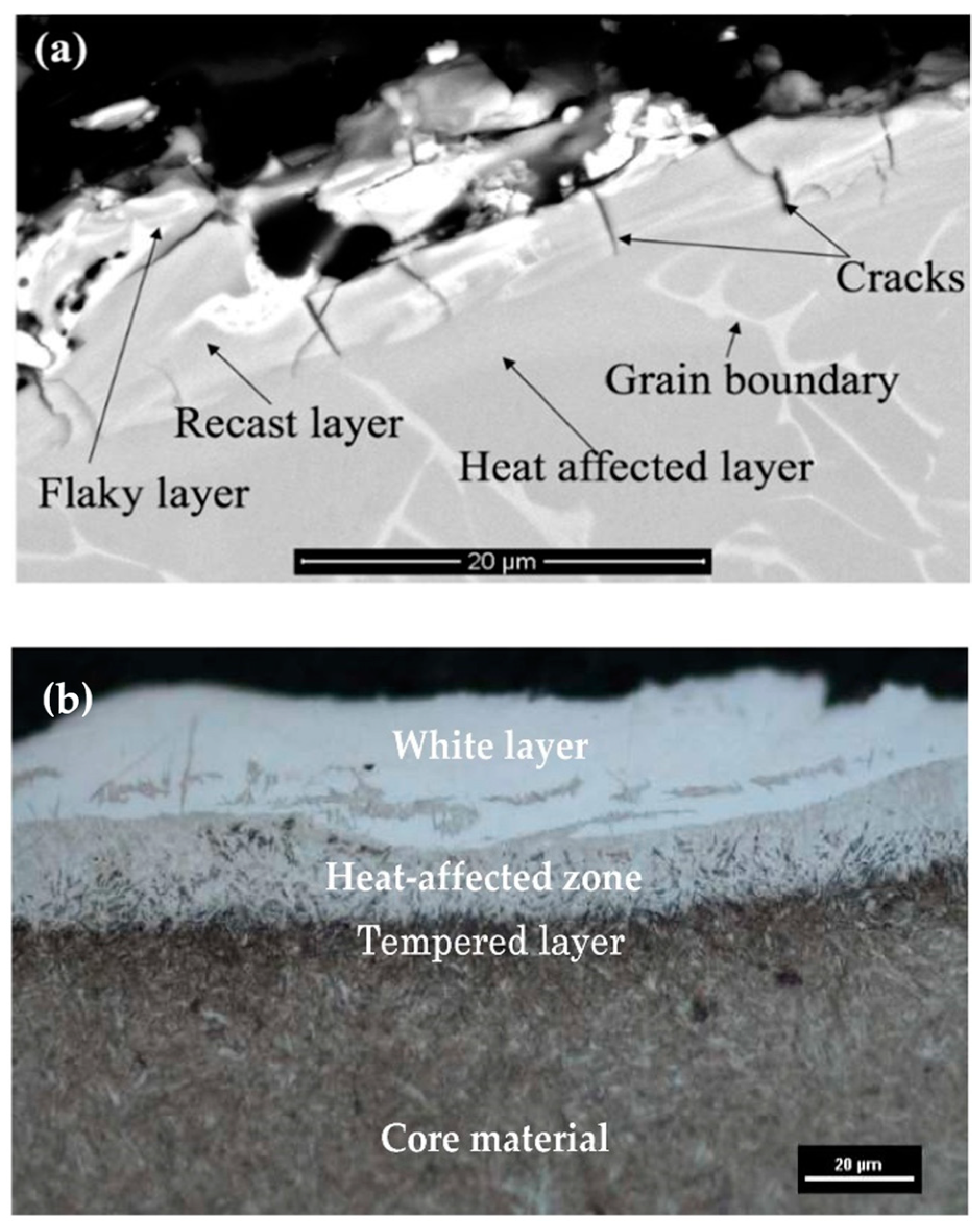
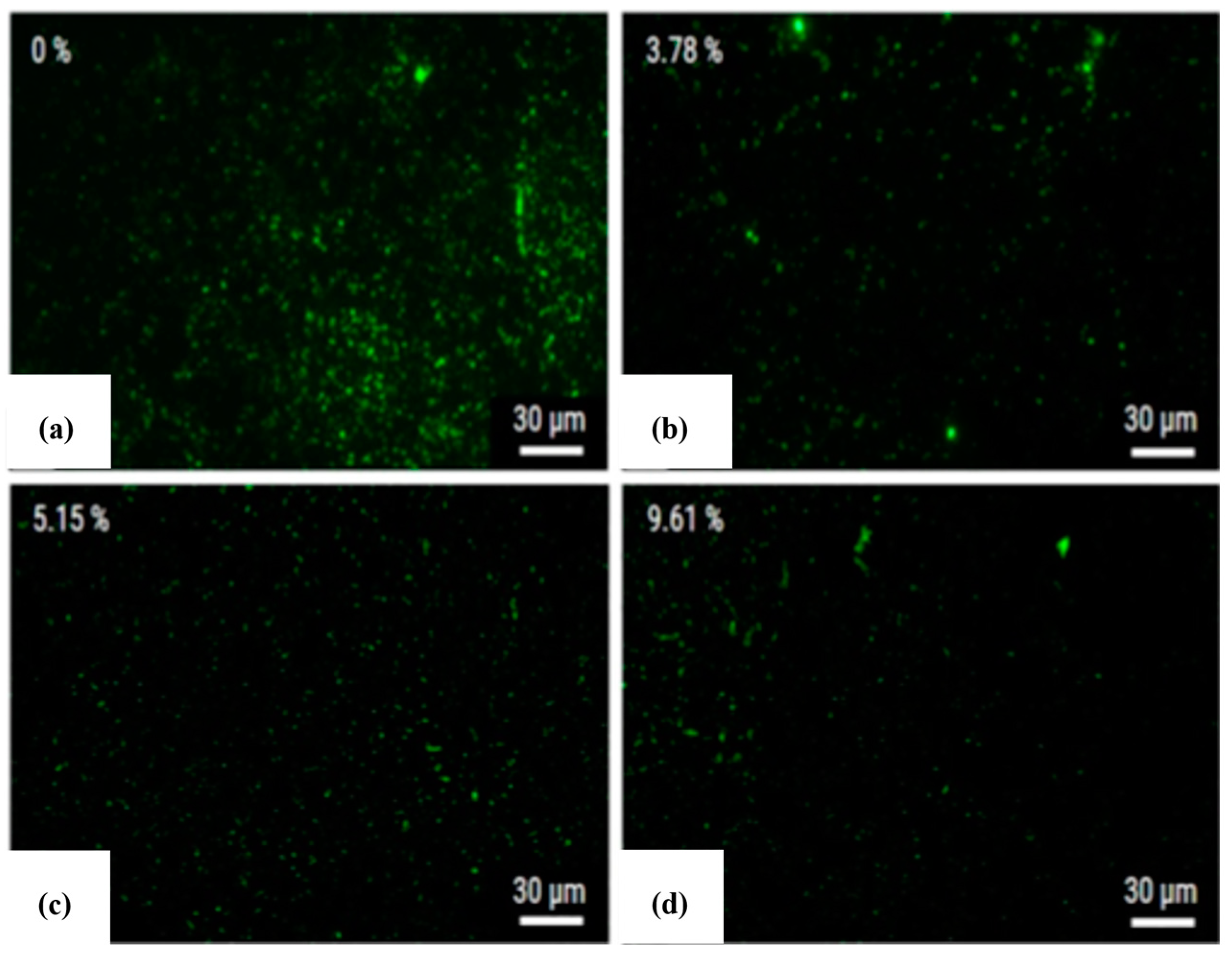

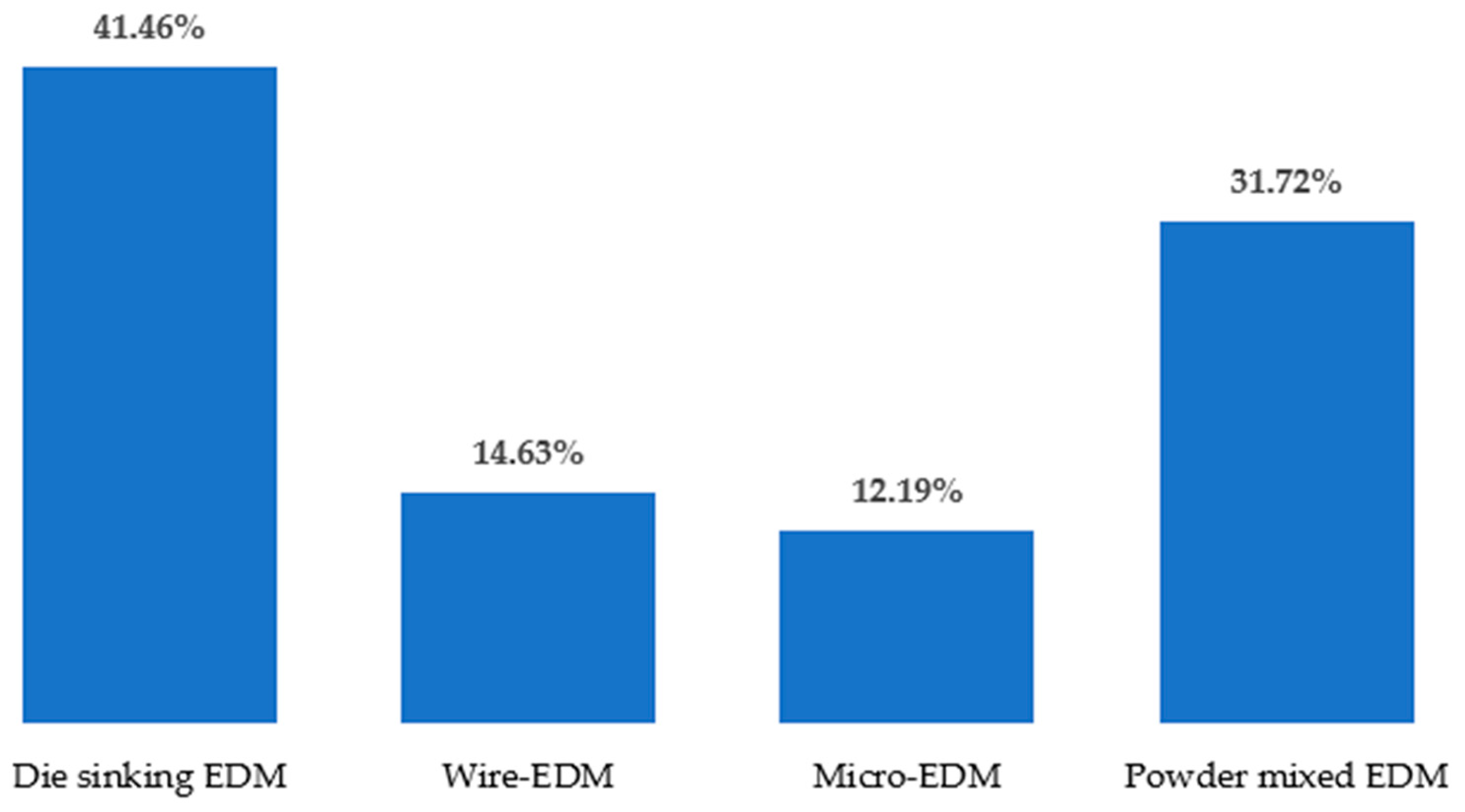
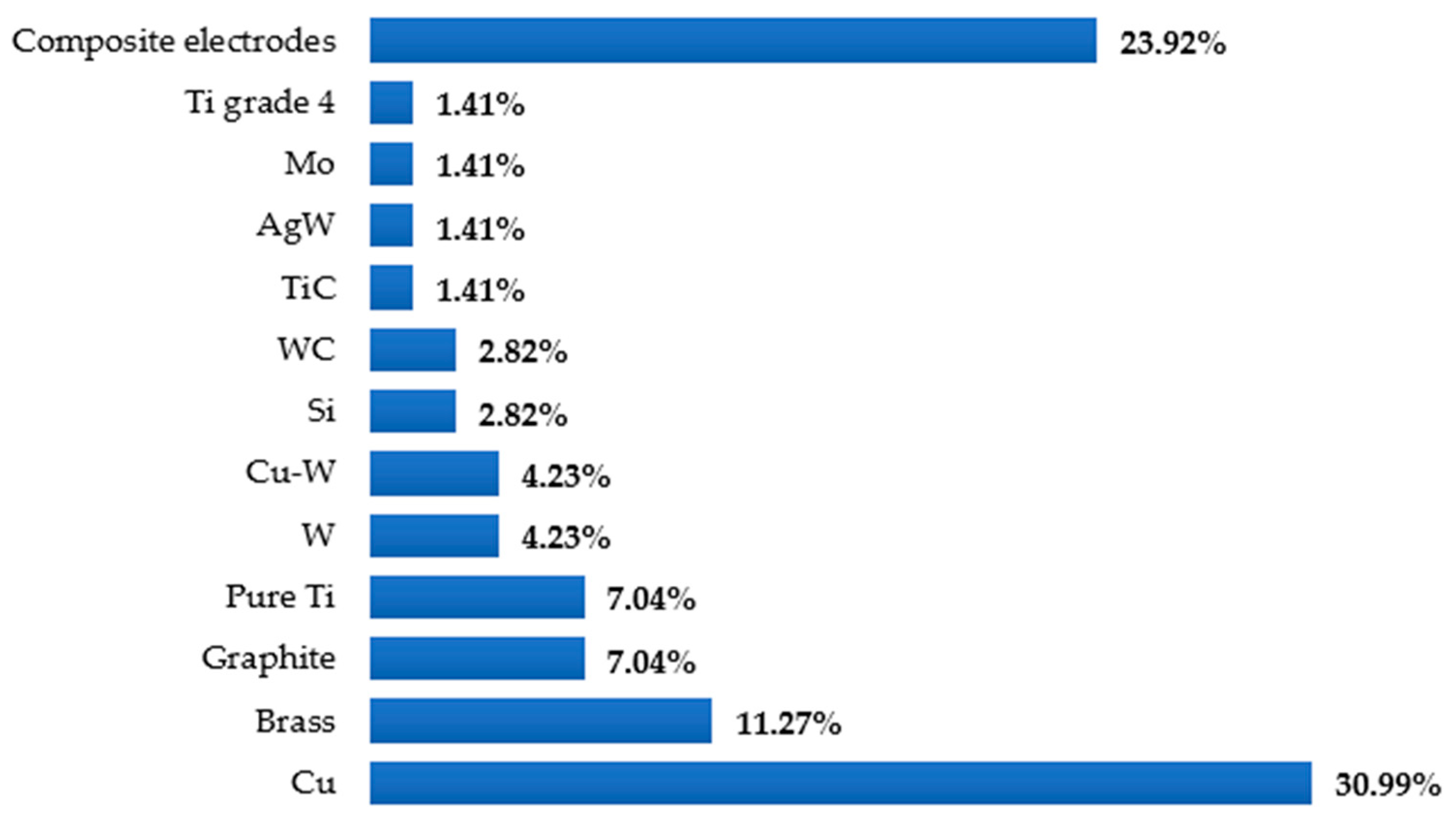
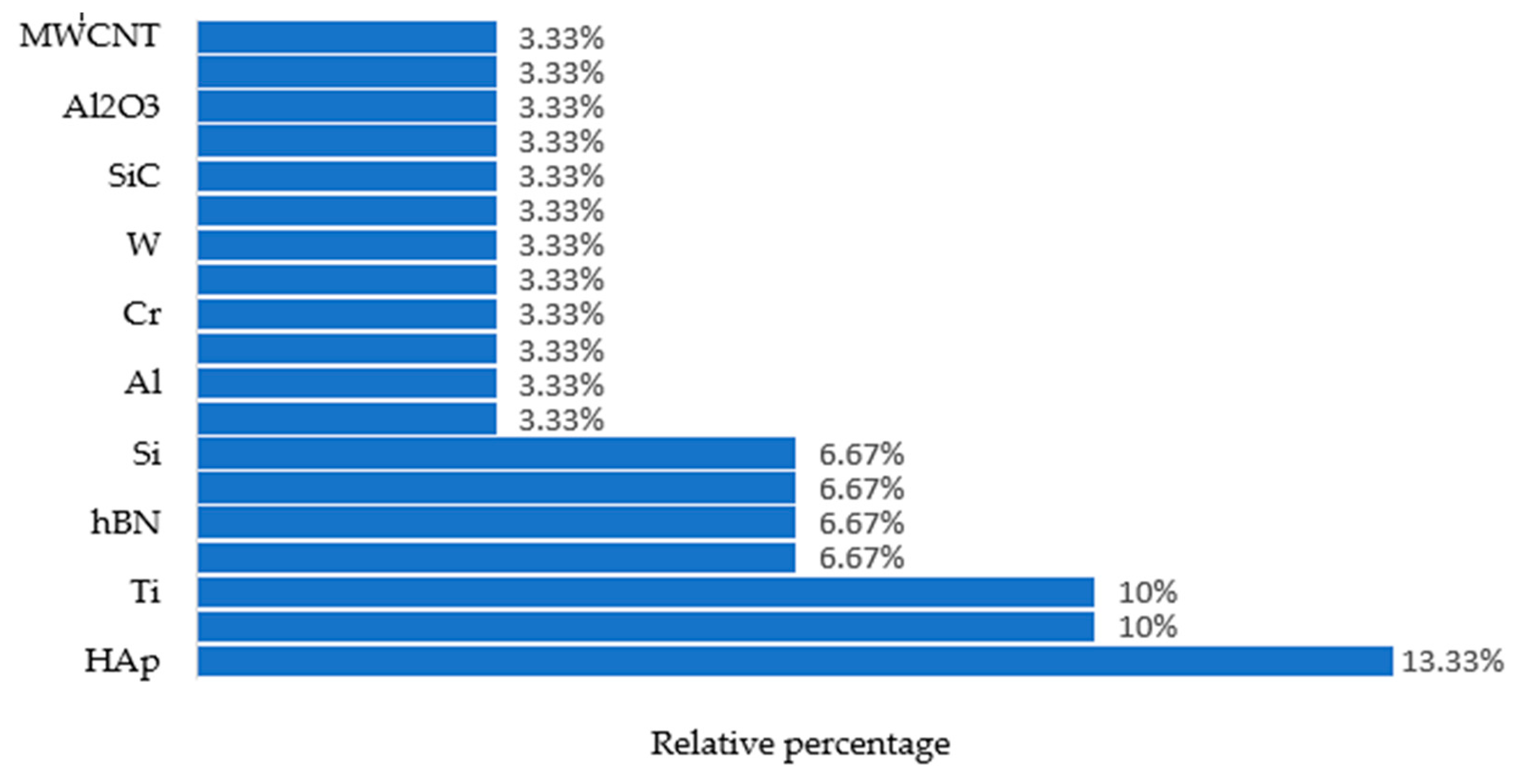
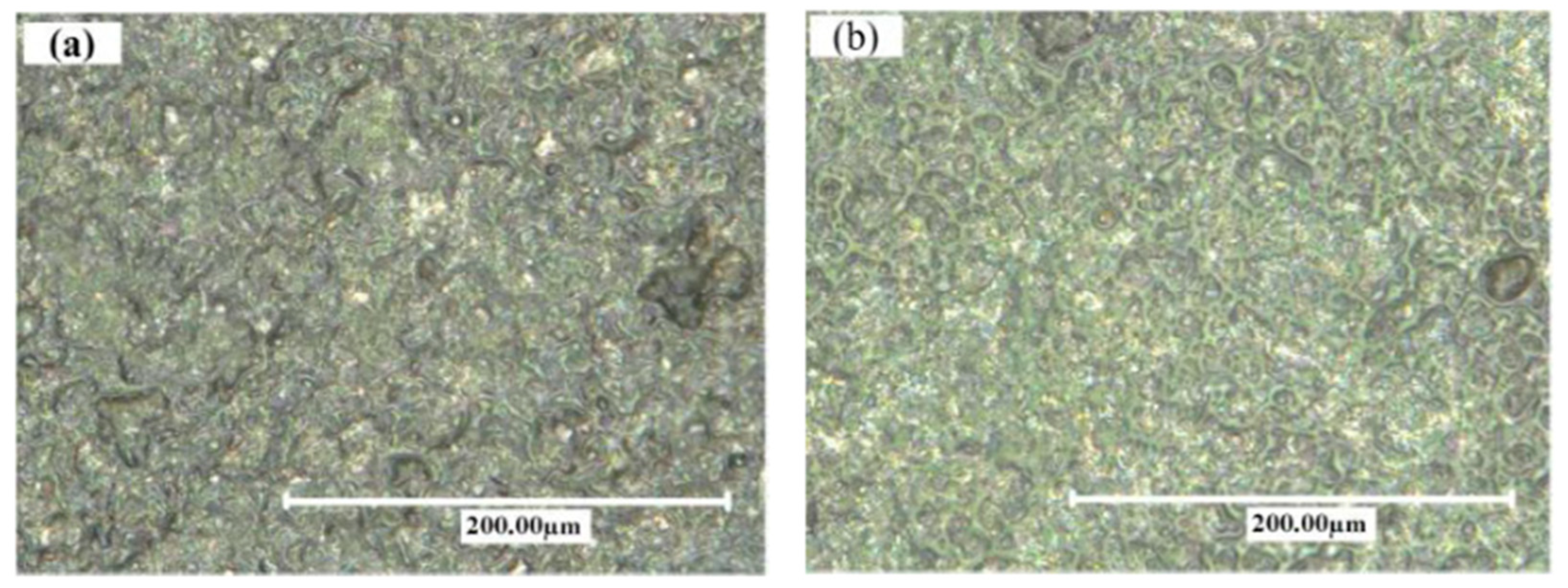
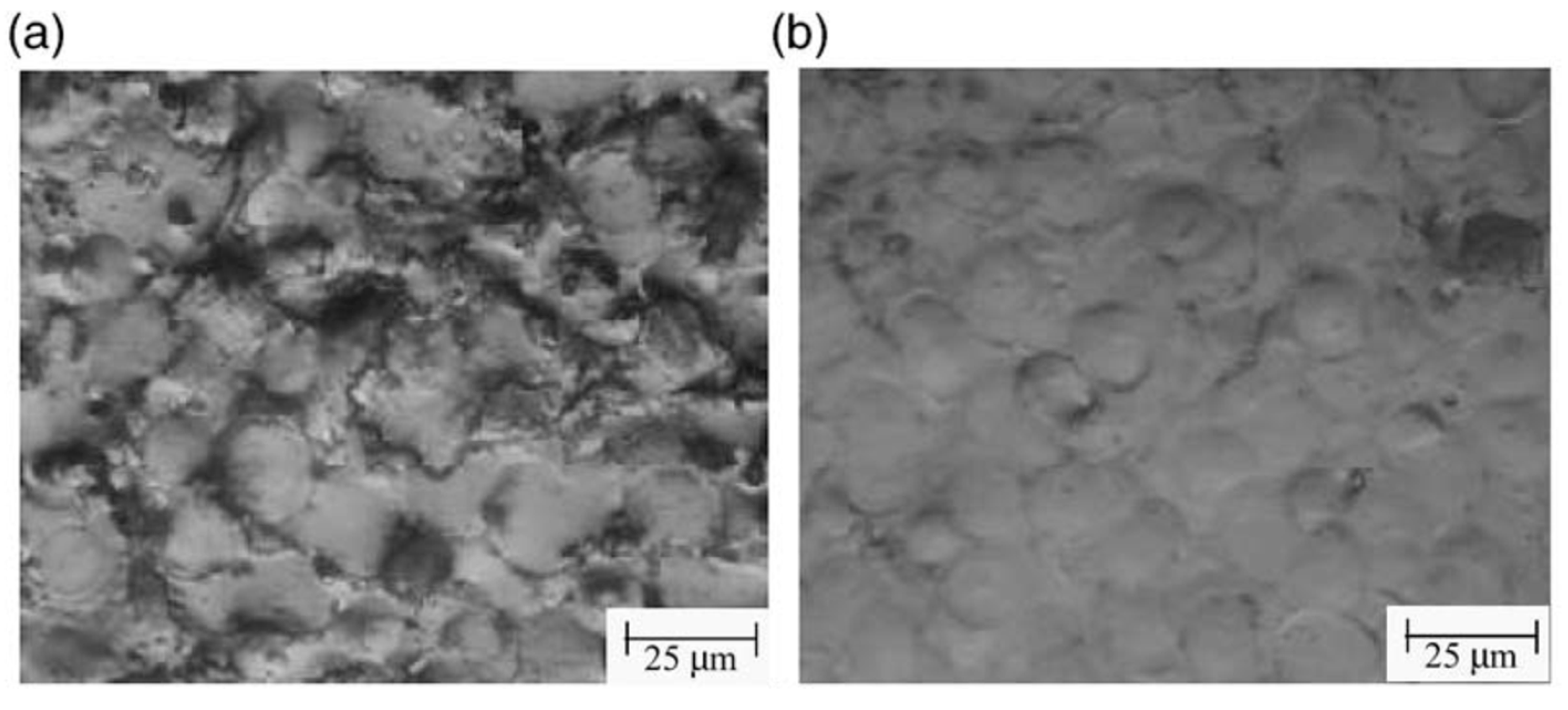

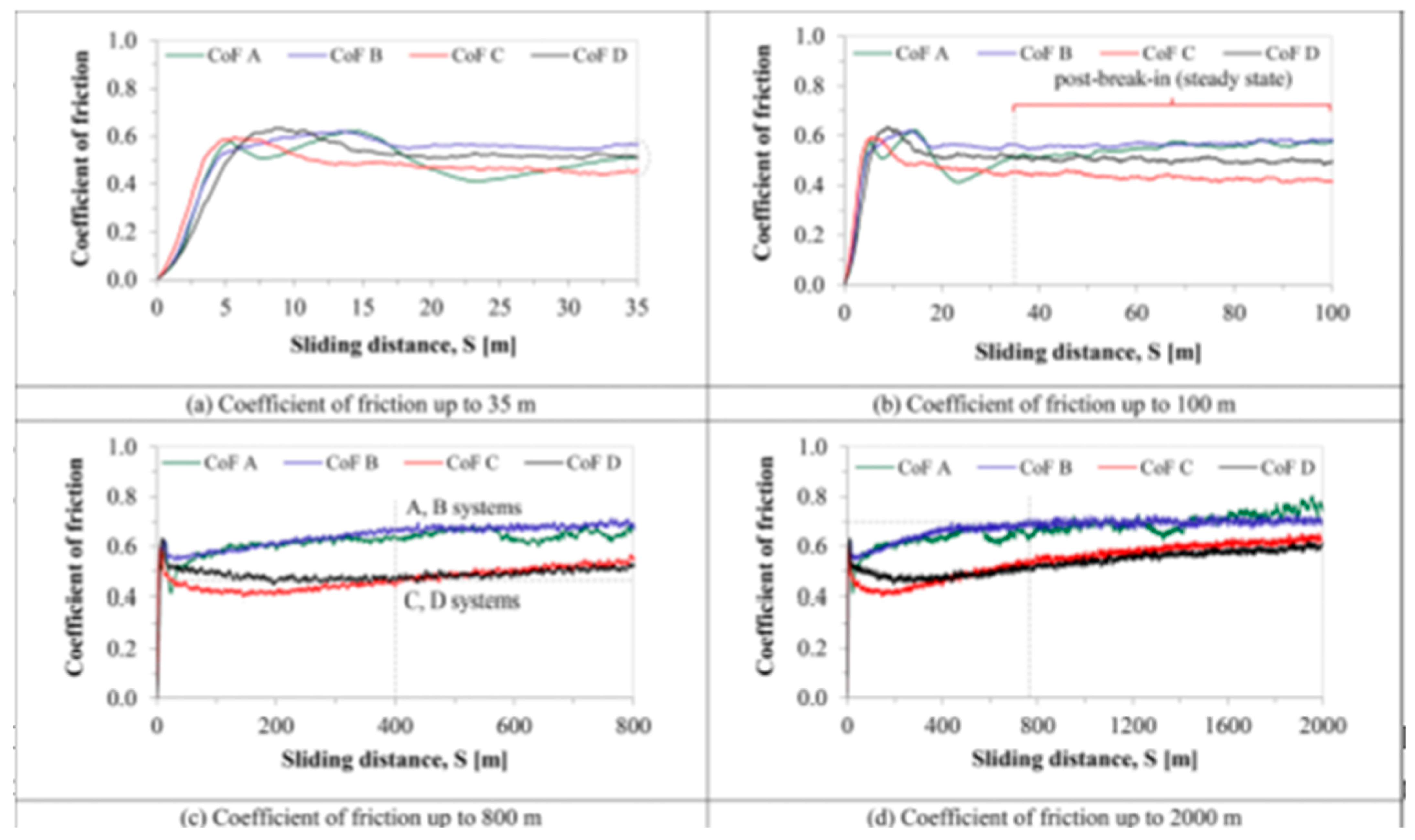
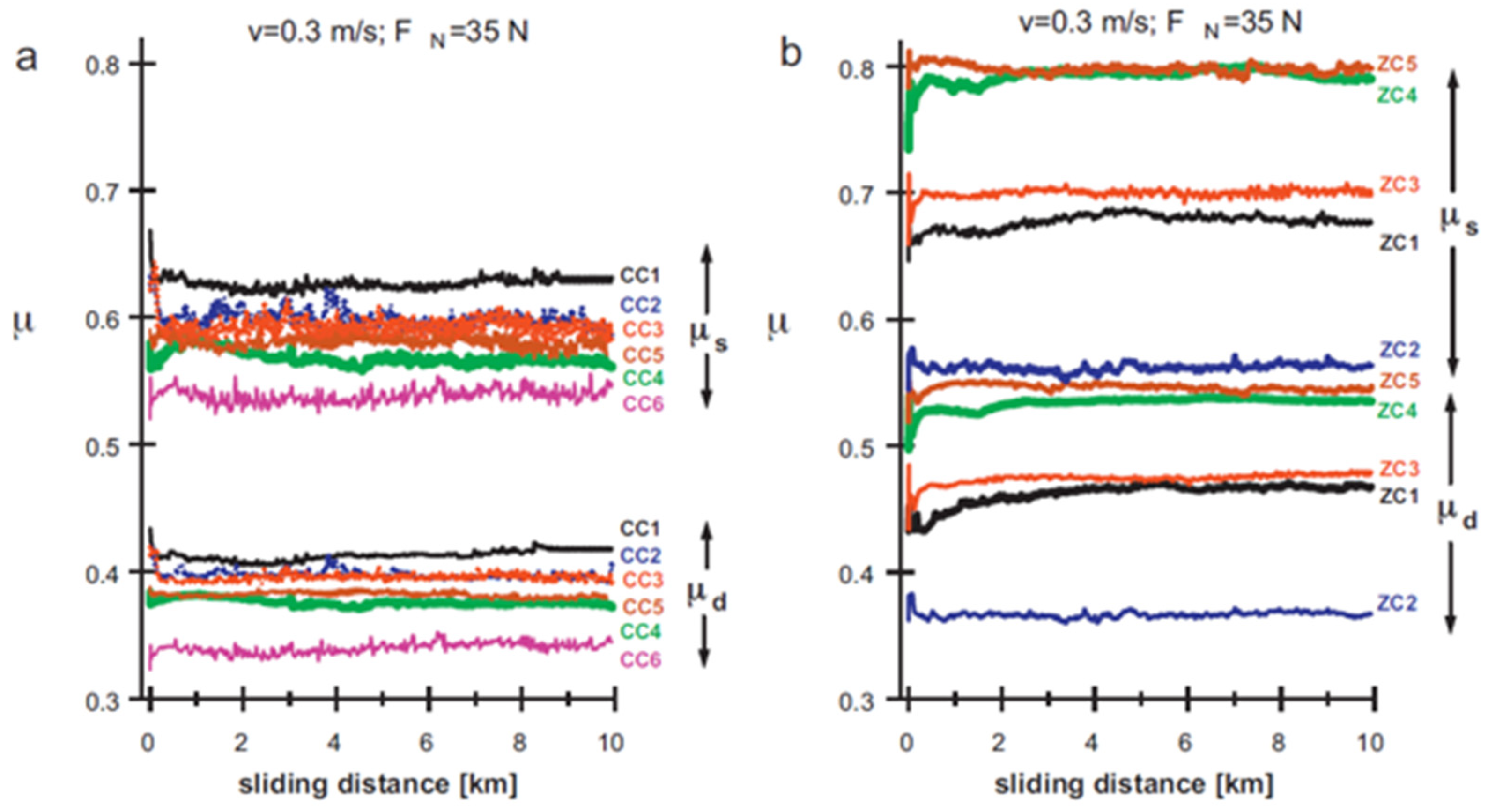
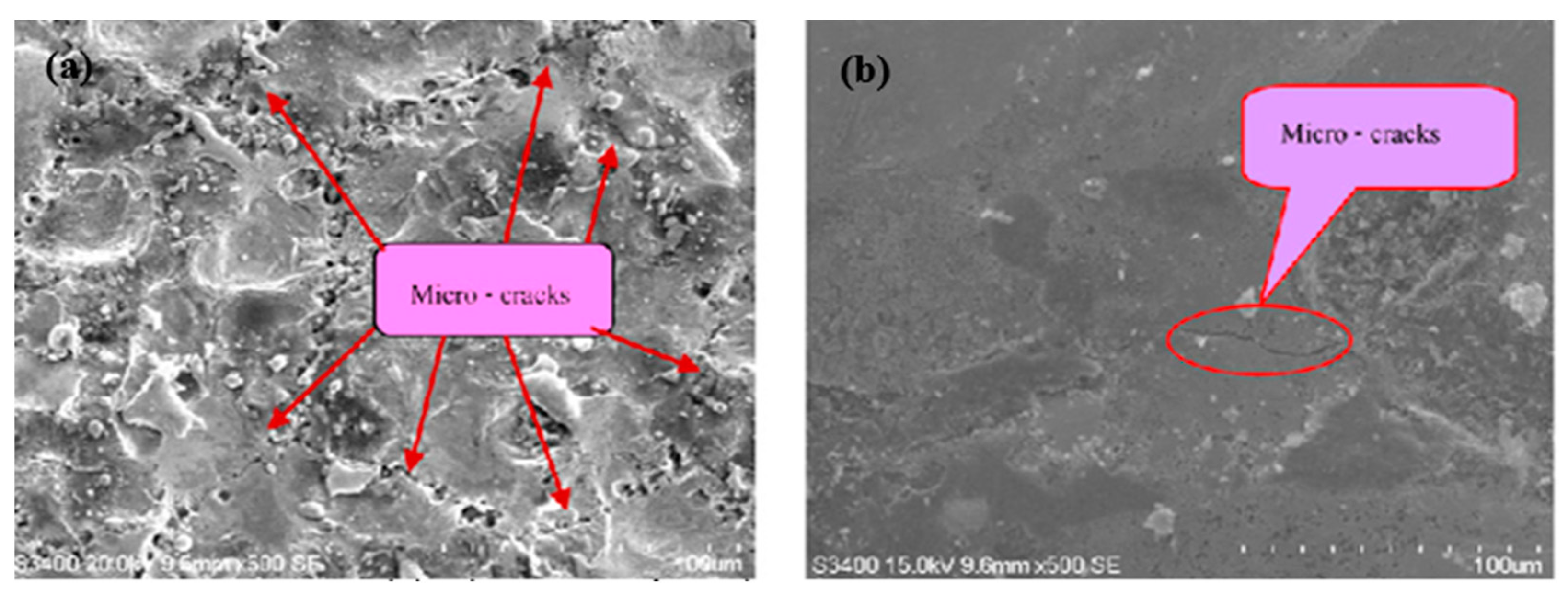
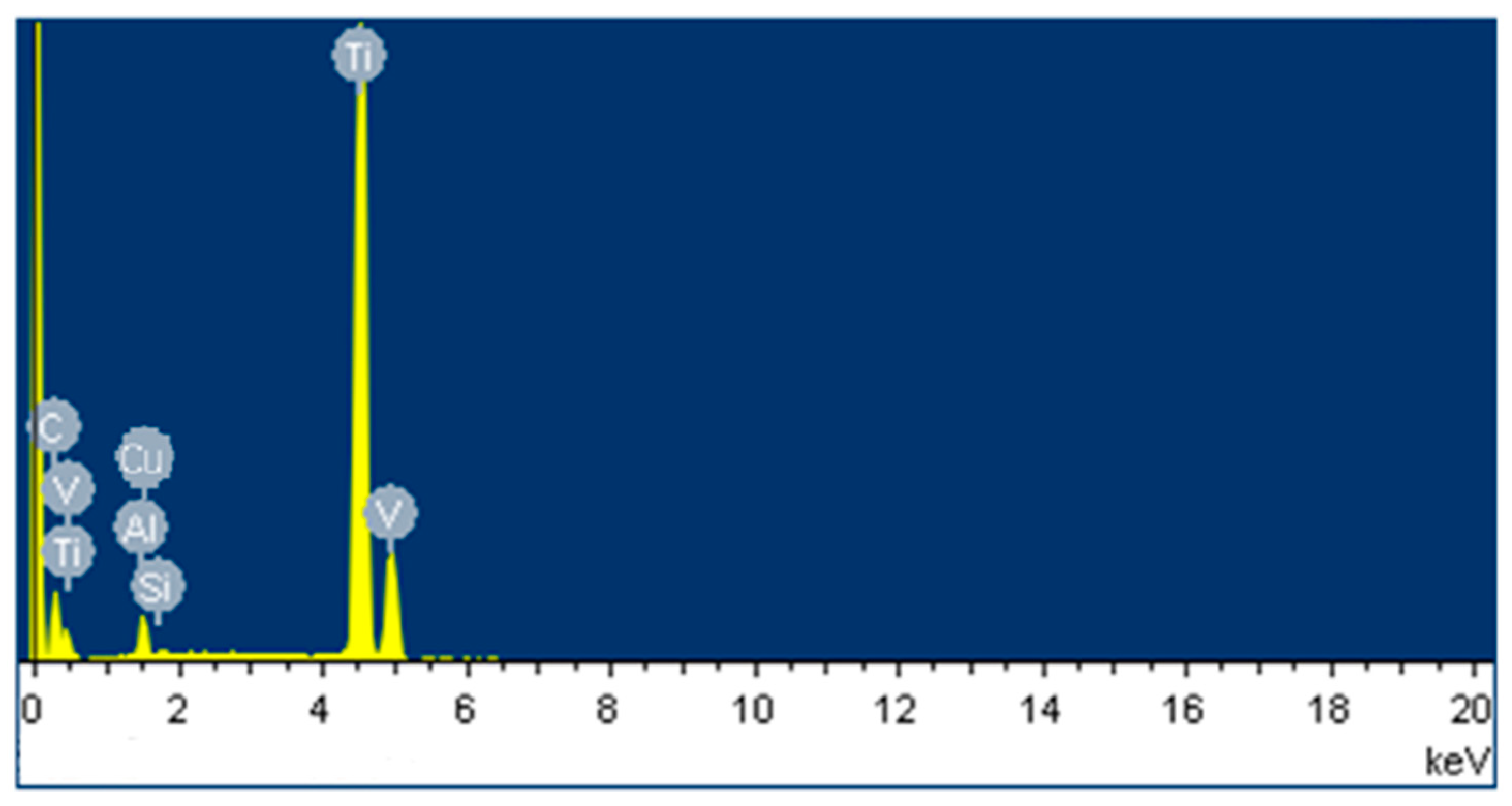
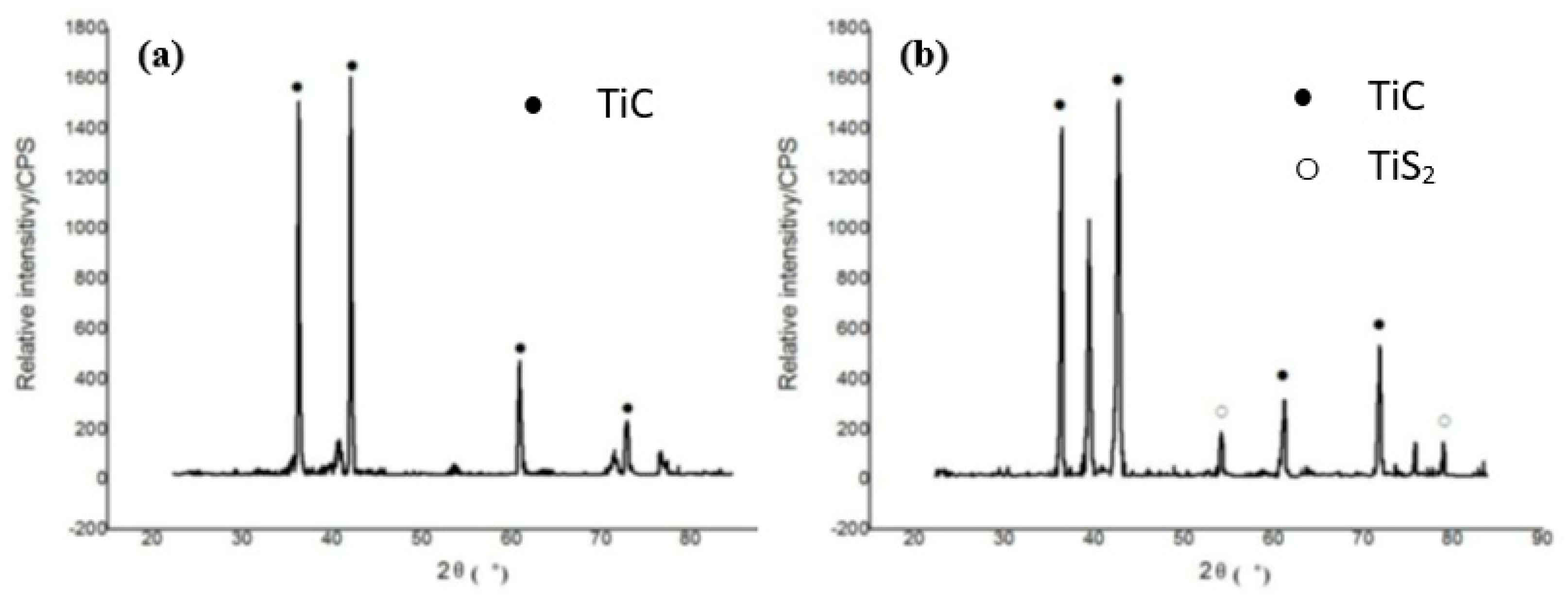

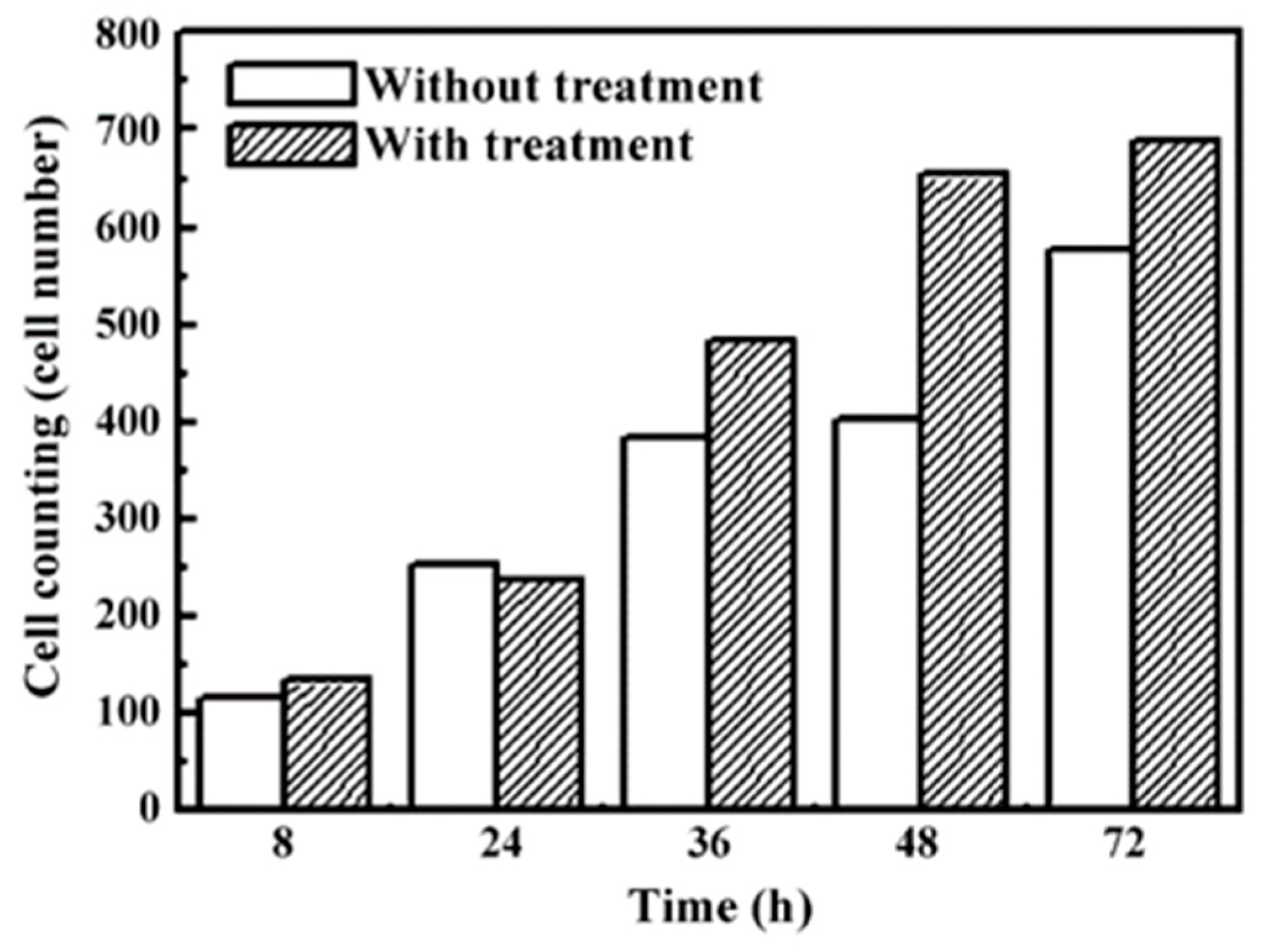
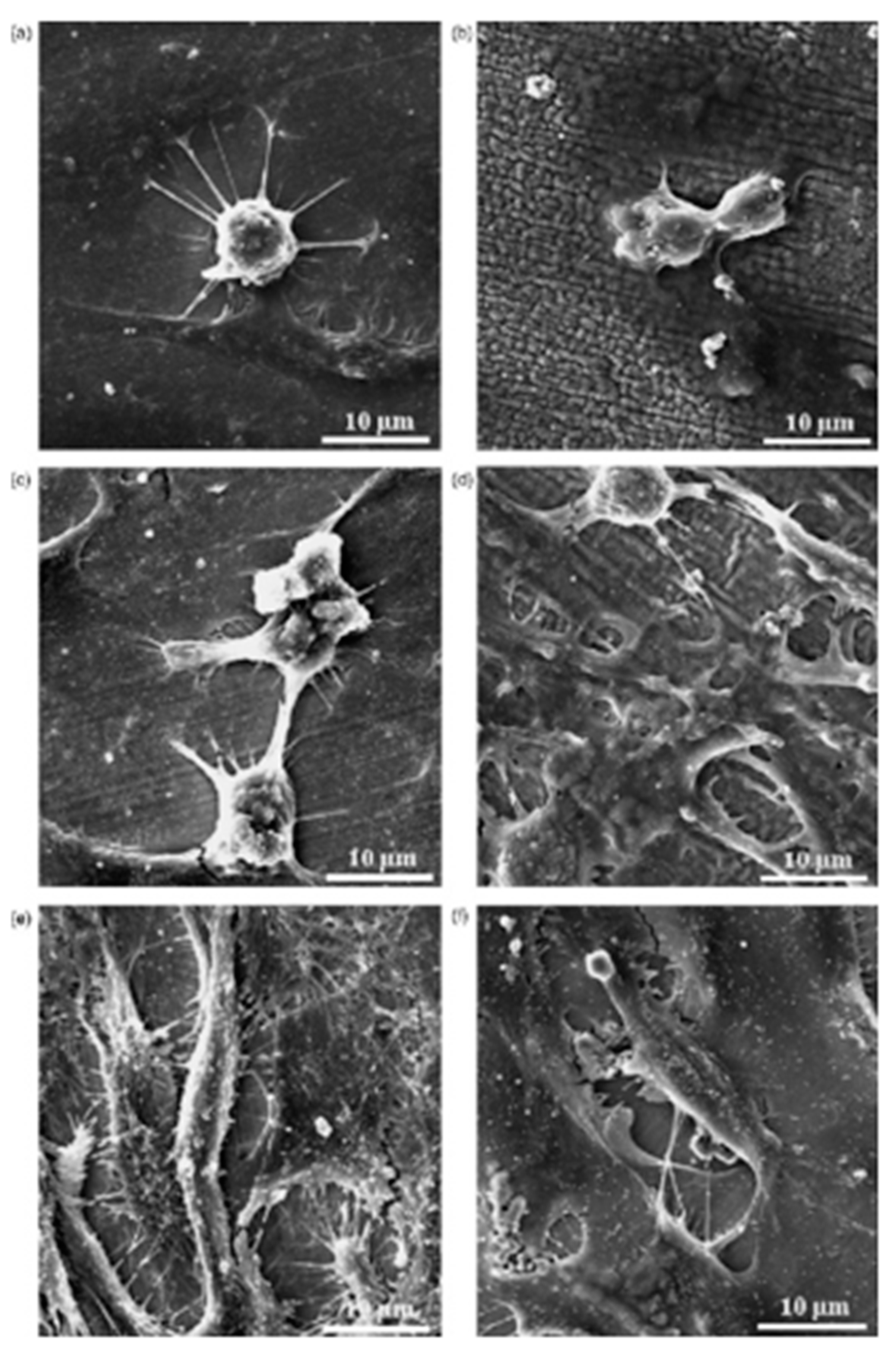


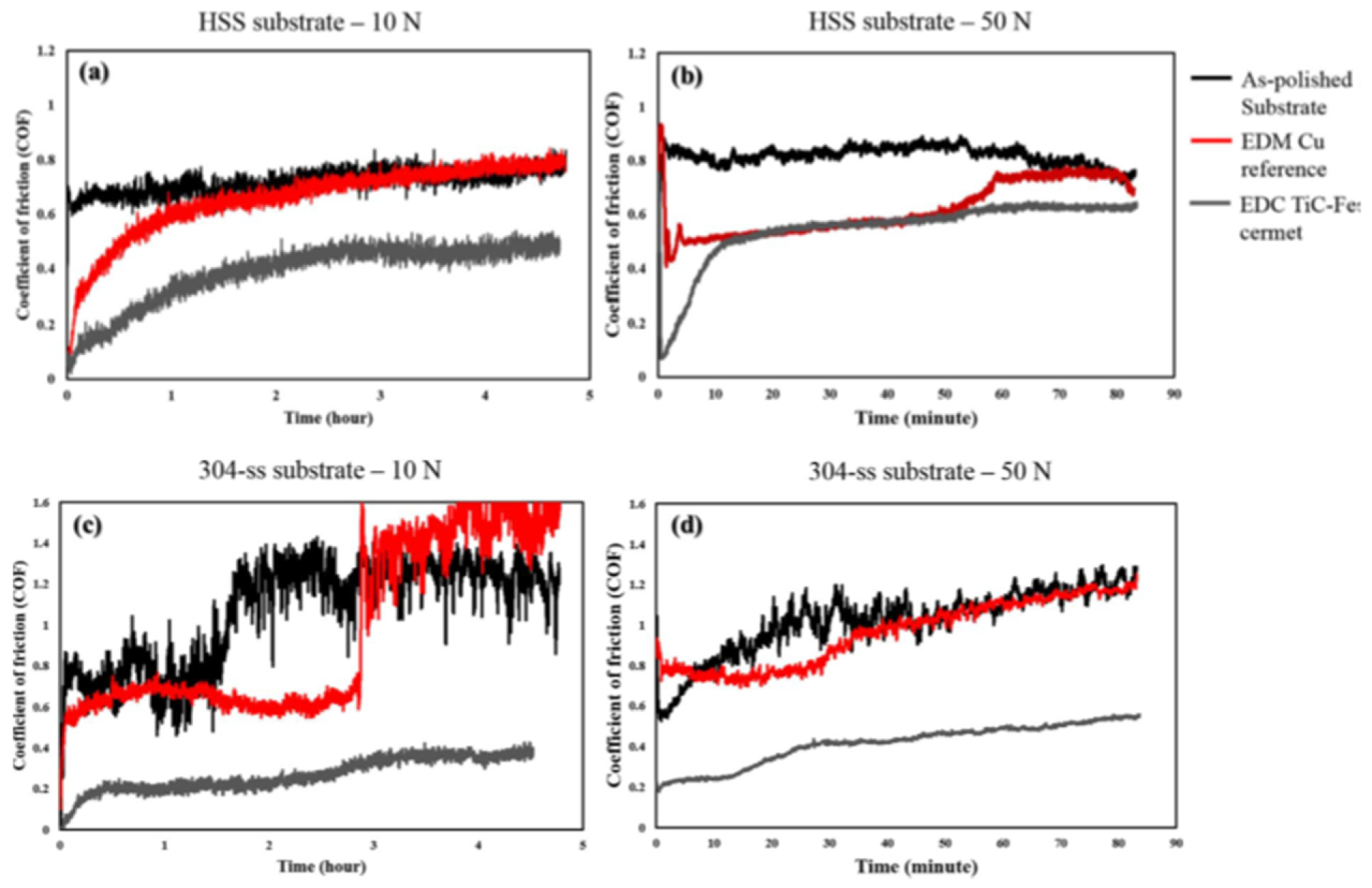
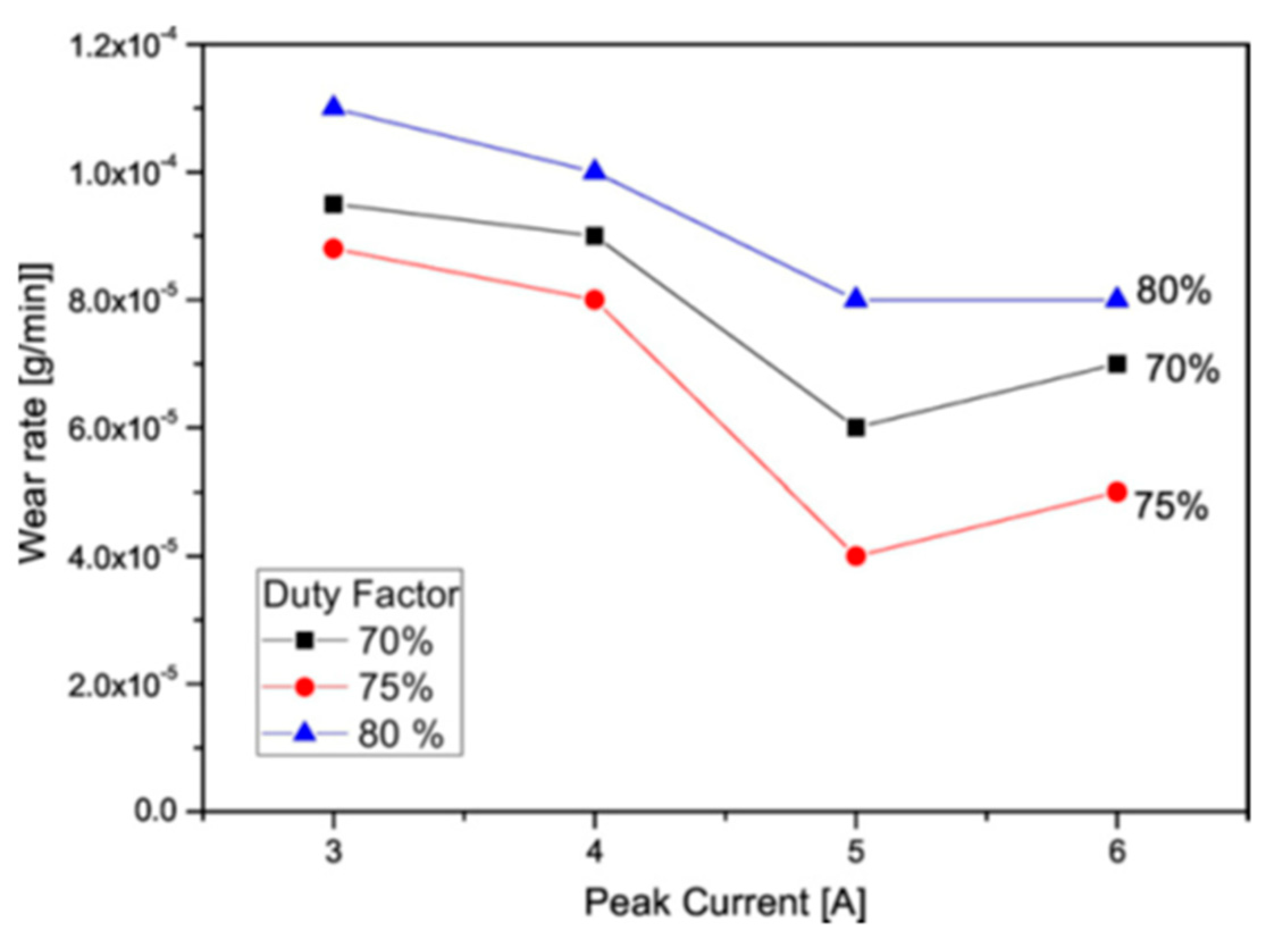


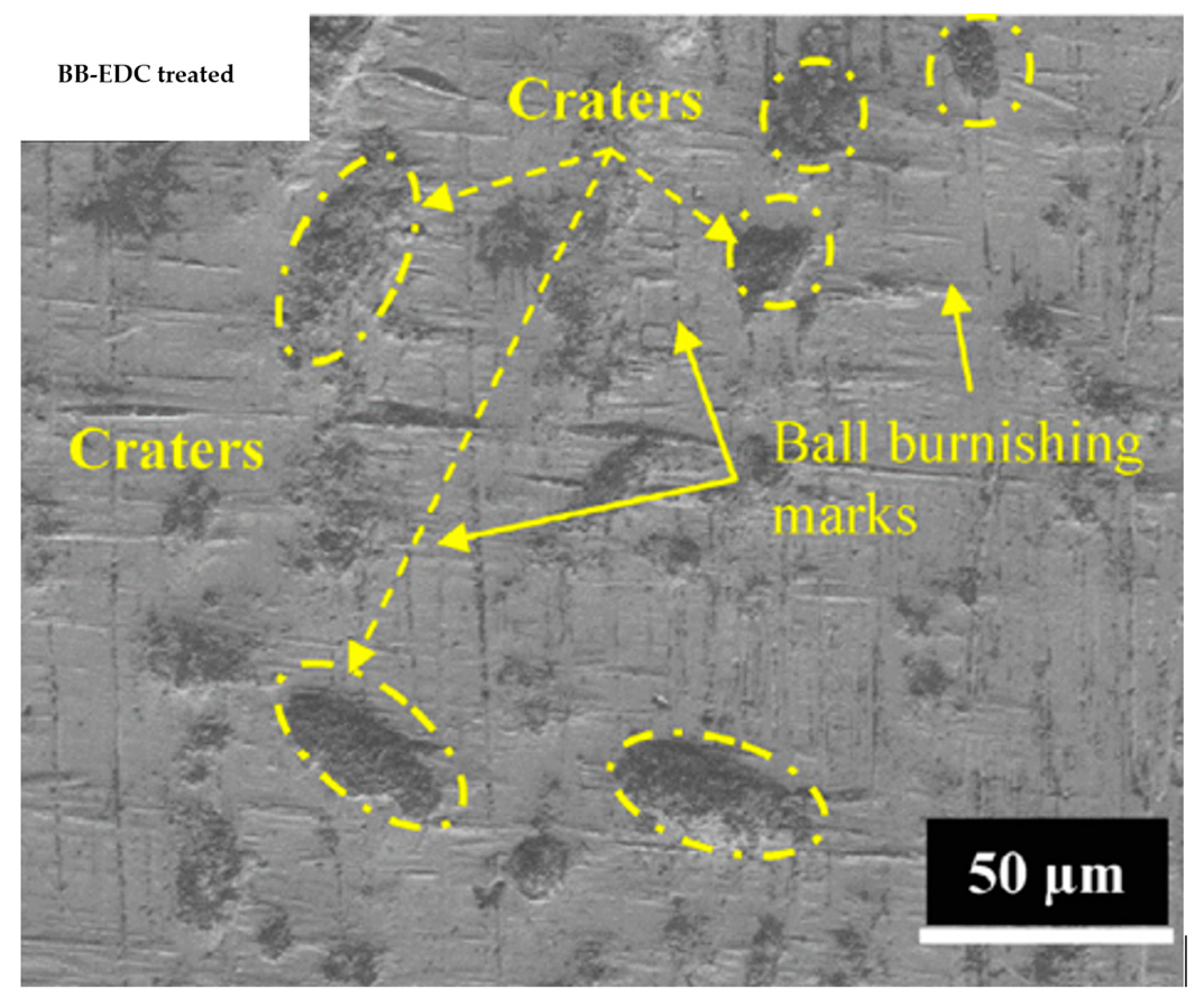



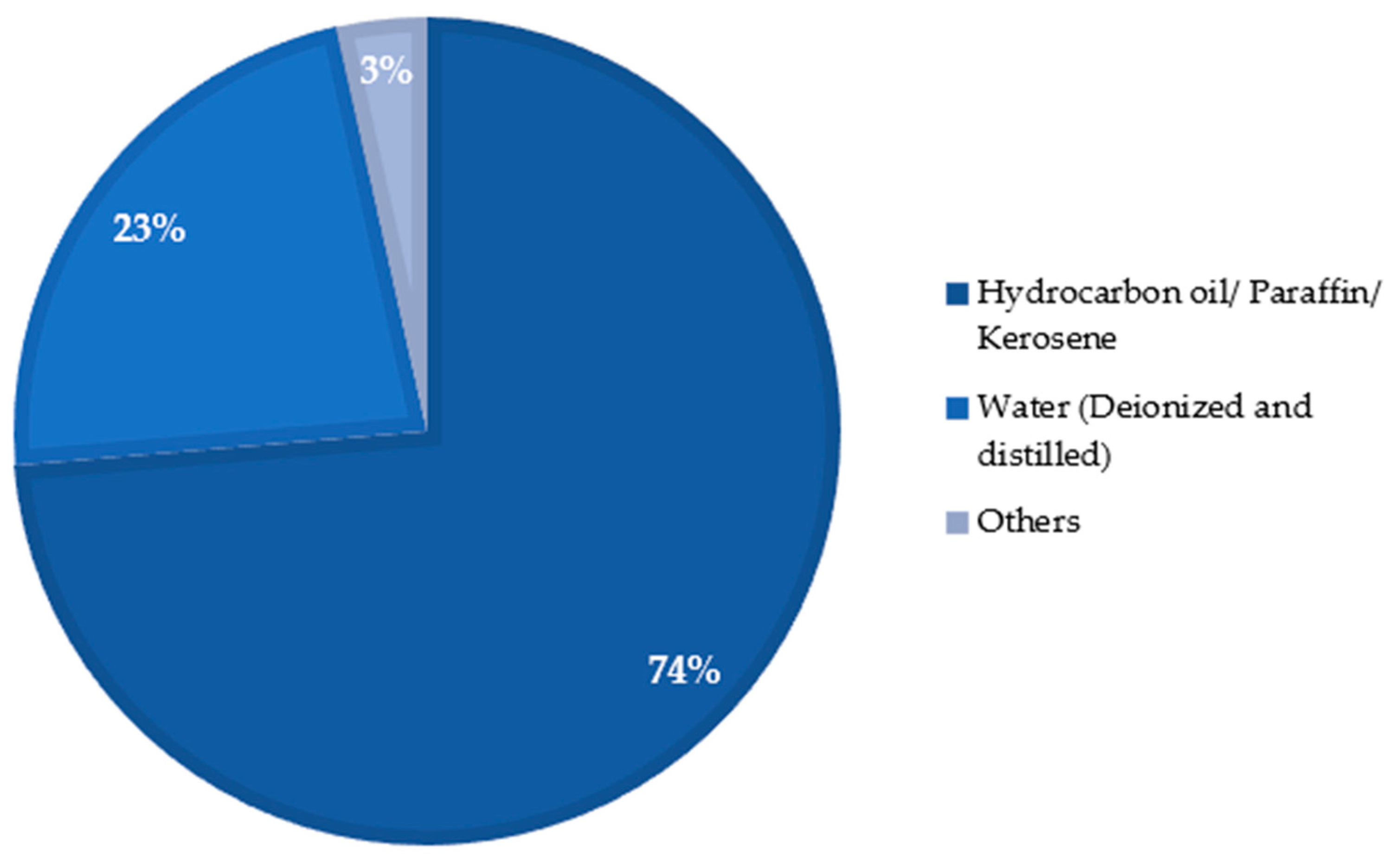
| Authors | EDM Type | Workpiece | Tool Electrode | Dielectric | Powder | Elements/Compounds in Newly Formed Layer |
|---|---|---|---|---|---|---|
| Mohri et al. [70] | DSEDM | C steel | Al green compact electrode | Hydrocarbon oil | - | Fe3C, AlFe3C0.5, α-Fe |
| Shunmugam et al. [71] | DSEDM | HSS | WC-Fe P/M electrode | Kerosene | - | WC, W2C, FeC, (Fe3C)H |
| Wang et al. [20] | DSEDM | C steel | Ti powder green compact electrode | Hydrocarbon oil | - | TiC, Fe |
| Ablyaz et al. [51] | DSEDM | Duplex SS | Graphite, Cu-W, W | EDM oil | - | O, oxide, tungsten carbides |
| Tsai et al. [64] | DSEDM | AISI 1045 medium C steel | Cu-Cr, Cu | Kerosene | - | Cu, Cr |
| Simao et al. [72] | DSEDM | AISI H13 steel | WC/Co partially sintered electrode | Hydrocarbon oil | - | WC |
| Patowari et al. [66] | DSEDM | C-40 grade steel | W-Cu | EDM oil grade 30 | - | W, W2C, Cu, Fe |
| Senthilkumar et al. [65] | DSEDM | Mild steel | Cu-40% B4C | Hydrocarbon oil | - | B4C, BFe2, CuB28, FeCu4 |
| Sidhom et al. [52] | DSEDM | 316L SS | Graphite | Paraffin oil | - | Cr7C3 |
| Patowari et al. [67] | DSEDM | C-40 grade steel | WC-Cu | EDM oil | - | WC, W2C, Cu, Fe |
| Afzaal Ahmed [29] | DSEDM | Al | Ti + B4C + Al P/M electrode | Hydrocarbon oil | - | AlB2, TiC, AlTi3, TiB2, Al4C3 |
| Mehmood et al. [49] | DSEDM | Al 2024 T6 | Cu | Kerosene | - | C |
| Arooj et al. [48] | DSEDM | Al 6061 T6 | Cu | Kerosene | - | Cu, O, C |
| Samrah et al. [69] | DSEDM | Al 7075 alloy | Inconel 718 + Al green compact electrode | Hydrocarbon oil | - | Al, Al3Ni, NbNi3, Fe5C2 |
| Hwang et al. [73] | DSEDM | Ni | Ti + Gr multilayer electrode | SE fluid 180 | - | TIC, C |
| Li et al. [68] | DSEDM | Ti-6Al-4V | Cu-SiC | EDM oil | - | Cu, Si, C, TiC, TiSi2 |
| Beri et al. [74] | DSEDM | Inconel 718 | Cu-W P/M electrode | EDM oil | - | Fe6W6C, Cr2F14C, N2Mo4C |
| Klocke et al. [75] | WEDM | Steel Vanadis 4 Extra | Brass wire | Hydrocarbon oil | - | Fe, Cu, Cr, Zn, Mo, V |
| Kumar et al. [76] | WEDM | Pure Ti | Brass wire | DI water | - | TiO2, TiO0.325, Ti2O3, Cu3TiO4, Ti3ZnC, Zn2Ti4C, TiC |
| Mahbub et al. [43] | WEDM | Ti-6Al-4V | Brass wire | DI water | - | Cu, Zn, TiO2 |
| Shinonaga et al. [77] | WEDM | Ti-6Al-4V | Brass wire | DI water | - | Ti2O3, TiO, Ti |
| Rahman et al. [78] | WEDM | Ti-6Al-4V | Mo wire | DI water in oil emulsion | - | Al(OH)3, V2O5, rutile |
| Bonny et al. [79] | WEDM | ZrO2-TiCN | Brass wire | DI water | - | ZrTiO4, ZrO2 |
| Molinetti et al. [80] | PMEDM | AISI H13 steel | Cu | Hydrocarbon oil | Mn, Si | SiC, FeSi, Mn4C, Mn4C2 |
| Khan et al. [81] | PMEDM | Mild steel | Cu-W | Kerosene | Al2O3, TiC | Cu, W, Al, C |
| Ekmekci and Ersoz [82] | PMEDM | IF steel | Cu | Tap water, oil | SiC | SiC, α-Fe, ɣ-Fe |
| Yan et al. [23] | PMEDM | Pure Ti | Cu | Distilled water | Urea | TiN |
| Devgan and Sidhu [83] | PMEDM | β-Ti | Graphite | DI water | MWCNT | TiC2, TiO, Ti2O3, Ti3O5, Nb2O5, TiH, ZrO2, ZrC, Nb2C |
| Chen et al. [84] | PMEDM | Grade 4 pure Ti | Grade 4 pure Ti | DI water | Ti | α-Ti, TiO |
| Tijo et al. [85] | PMEDM | Ti-6Al-4V | Cu | Kerosene | Ti, B4C | TiB2, TiB, TiC, TiO2, Ti, C |
| Bains et al. [86] | PMEDM | Ti-6Al-4V | Cu | EDM oil | n-HA | TiC, TiO2, VSi2, Ca3(PO4)2, P, CaTiO3 |
| Janmanee and Muttamara [87] | PMEDM | WC90-Co10 | Cu | Shell EDM Fluid 2A | Ti | TiC |
| Hu et al. [53] | PMEDM | SiCp/Al | Cu | Kerosene | Al | C, Al, Si, SiC |
| Singh et al. [58] | PMEDM | Super Co 605 | Graphite | EDM oil | Graphite | C |
| Sharma et al. [59] | PMEDM | Mg-4Zn | Cu | EDM oil | Zr, Mn | Carbides of powder elements |
| Abdu Aliyu et al. [88] | PMEDM | Zr-based BMG | Pure Ti | Hydrocarbon oil | HA | ZrC, TiC, CaTiO3 |
| Jahan et al. [30] | µ-EDM | NiTi | WC | Commercial EDM oil | - | NiTiO3, W |
| Jahan et al. [62] | Milling µ-EDM | Tungsten carbide | W | EDM oil | Graphite | C |
| Davis et al. [63] | PM µ-EDM | Ni55.6Ti44.4 | Cu, Brass | EDM oil | Zn | Metal oxides and carbides |
| Jahan et al. [61] | DS µ-EDM | Tungsten carbide | W, CuW, AgW | EDM oil | - | C |
| Mohanty et al. [89] | PM µ-EDM | Ti-6Al-4V | Brass | DI water | hBN | Ti, TiAlN, TiN, Al2O3, BN, ZnO, CuO, TiO2 |
| EDM Type | Workpiece | Powder | Remarks |
|---|---|---|---|
| Conventional EDM [122] | Fe-Al-Mn Alloy | - | Resulted in improved biocompatibility and osseointegration, more cell attachment |
| Conventional EDM [123] | Ti-6Al-4V | - | Osteoblastic cells completely spread on the EDMed surface. Noticeable MG-63 cells attachment and proliferation confirmed its usability for clinical purposes. |
| Conventional EDM [126] | Co-Cr and Ti | - | Ti electrode was better compared with the Cu electrode in manufacturing Co-Cr and Ti dental alloys. |
| DSEDM [117] | Ti50Ni50, Ti50Ni49.5Mo0.5 and Ti30Nb1Fe1Hf | - | Defects on the recast layer were insignificant. TiO was found on TNM and TNB. Surface roughness was favorable for oral implants. |
| WEDM [43] | Ti-6Al-4V | - | Presence of β and α + β helped with cell attachment. A TiO layer formed, which prevented the implant from being corroded, thus resulting in a better biofunctionality. |
| µ-EDM [30] | Ti-6Al-4V and NiTi | - | TiO2 and WO2 layers formed in the case of Ti-6Al-4V alloy and NiTiO3 film formed over NiTi. These layers resulted in an improved biocompatibility. |
| PMEDM [59] | Mg/Zn | Zr, Mg | Biocompatibility and corrosion resistance was better when Zr powder was used. |
| PMEDM [127] | 316L steel | Hap | A thin coating formed on the specimen. The authors obtained 70% of living cells, which indicated an improved cell proliferation as well as biocompatibility. |
| PM-µEDM [129] | Mg alloy AZ91D | Hap | A glossy recast layer was formed, and an increased hydrophobicity was achieved. As a result, the modified surface can be used in medical sectors. |
| PM-µEDM [63] | Ni55.6Ti44.4 | Zn | Higher cell viability percentage ensured a tremendous role of the modified alloy in the broken tissue recovery, and this modified alloy is suitable for cardiovascular applications. |
Disclaimer/Publisher’s Note: The statements, opinions and data contained in all publications are solely those of the individual author(s) and contributor(s) and not of MDPI and/or the editor(s). MDPI and/or the editor(s) disclaim responsibility for any injury to people or property resulting from any ideas, methods, instructions or products referred to in the content. |
© 2022 by the authors. Licensee MDPI, Basel, Switzerland. This article is an open access article distributed under the terms and conditions of the Creative Commons Attribution (CC BY) license (https://creativecommons.org/licenses/by/4.0/).
Share and Cite
Nafi, M.A.; Jahan, M.P. Functional Surface Generation by EDM—A Review. Micromachines 2023, 14, 115. https://doi.org/10.3390/mi14010115
Nafi MA, Jahan MP. Functional Surface Generation by EDM—A Review. Micromachines. 2023; 14(1):115. https://doi.org/10.3390/mi14010115
Chicago/Turabian StyleNafi, Muhammad Abdun, and Muhammad Pervej Jahan. 2023. "Functional Surface Generation by EDM—A Review" Micromachines 14, no. 1: 115. https://doi.org/10.3390/mi14010115
APA StyleNafi, M. A., & Jahan, M. P. (2023). Functional Surface Generation by EDM—A Review. Micromachines, 14(1), 115. https://doi.org/10.3390/mi14010115






